Black and white moths are native to North America, Europe, and Asia. These moths are also seen in high numbers across Central and South America.
The native species in North America tend to have a bad reputation as many black and white moths are seen as pests.
They invade hardwood trees, decorative trees, and even crops that they can completely defoliate.
Some of the most common black and white species in North America and across the world can be categorized as follows.
Table of Contents
1. Salt Marsh Moth
Salt Marsh moths (Estigmene acrea) are some of the most common black and white moths in North America and Africa.
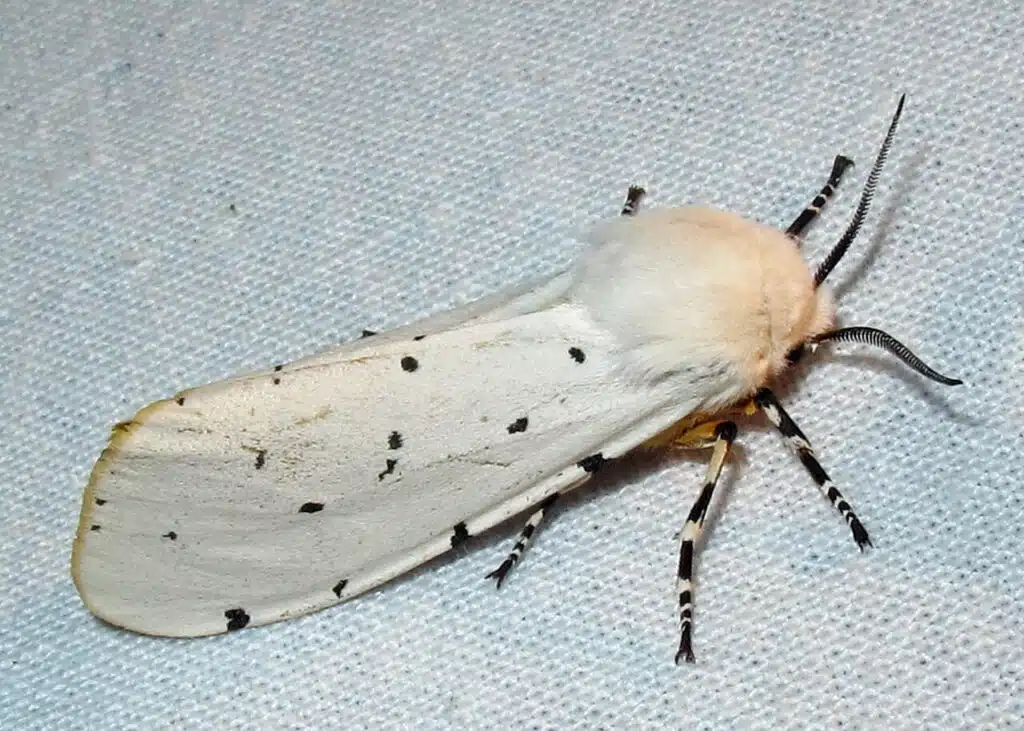
This species has a widespread US presence as well as a high presence in African countries such as Congo.
Black and white are the main colors of its forewings.
White is the base color while black dots cover the entire surface of the wings.
Its hindwings are orange with similar tiny black dots but in a lesser number.
The upper body of the species is white and black whiles its lower body is orange and black.
Growing to a wingspan of at least 1.2 inches, this species is seen at different times of the year depending on its region.
Southern Florida and Southern Texas are the only habitats where the Salt Marsh moth is active all year long.
Elsewhere, this species is only active until august.
Some of the best places to see this moth include cabbage fields and cotton fields where it’s seen as a pest.
Salt Marsh moths are also seen on potato and pea crops to a lesser extent.
2. Fall Webworm Moth
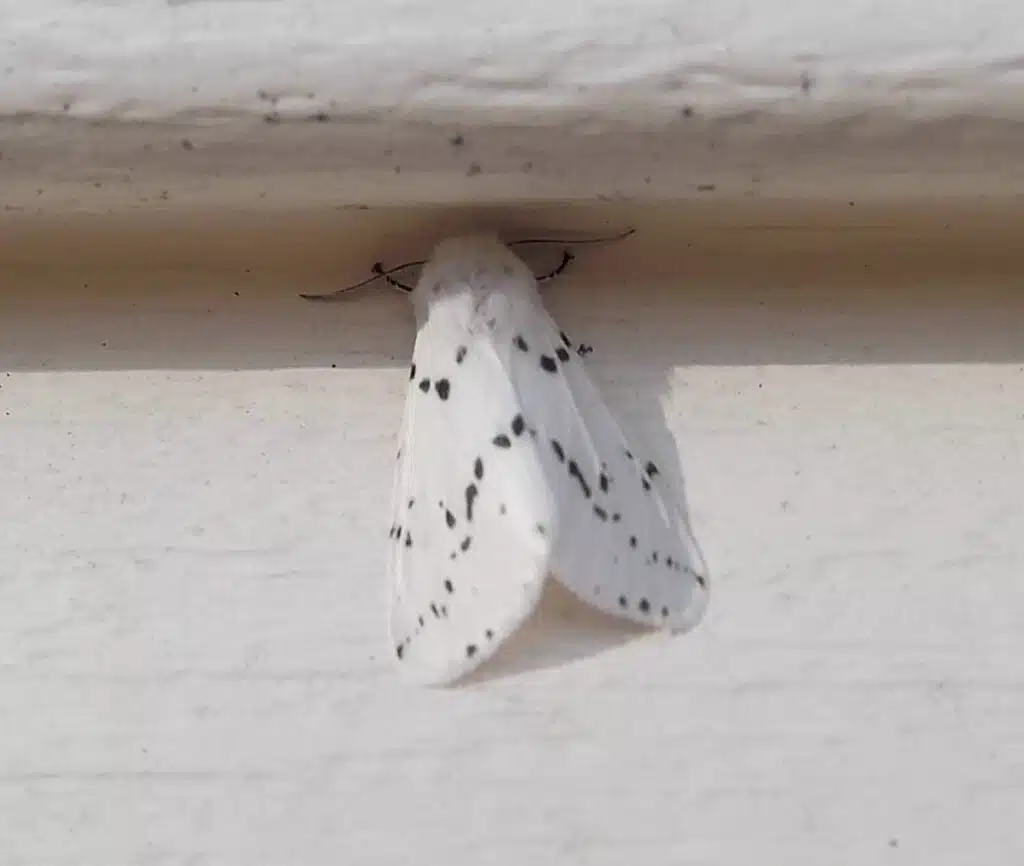
Fall Webworm moths (Hyphantria cunea) are some of the most common black and white moths in North America. This species has a white base color with black dots.
It also comes in an all-white color.
Seeing Fall Webworm moths isn’t a happy time since these moths are pests of various trees and crops.
The damage they cause is mainly seen during their caterpillar stage when they can defoliate entire trees and crops.
It’s often common to see a silk web across the leaves the caterpillars defoliate.
Seen on various legumes, Fall Webworm caterpillars are mostly detrimental to alder, willow, elm, and walnut trees.
While these moths have a reduced size with a maximum wingspan of up to 1.7 inches, they can still inflict considerable damage to these trees and even kill them.
As white moths, they also attract plenty of natural predators. However, these moths have a reduced number of predators in certain areas of the country.
Predatory wasps are the biggest threat to Fall Webworm moths.
3. Clymene Moth
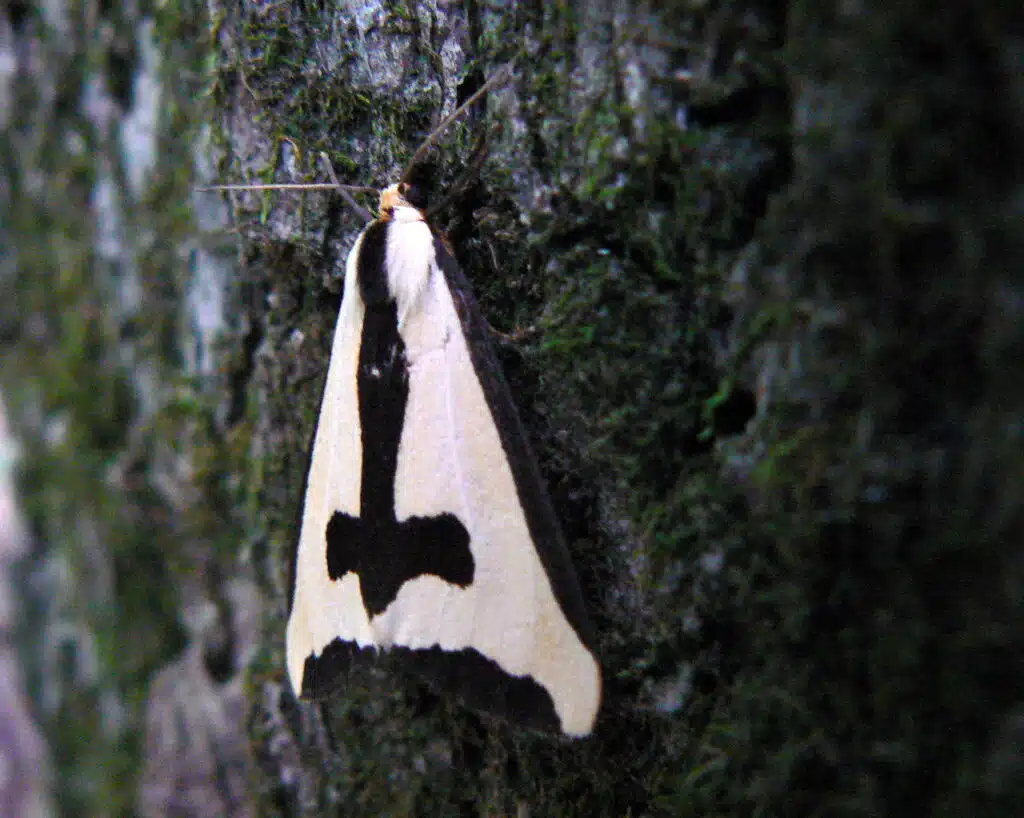
Clymene moths (Haploa clymene) are known to have a black and white color with their wings closed.
When their wings are close together only the upper wings are visible. These are white with a black central line.
Clymene moths have orange hindwings which are only seen when their wings are fully open.
As part of a defensive strategy, the colored hindwings of the species are only shown when predators approach or when the moth flies.
This species has a widespread presence in Eastern US territories.
Found in all habitats from Canada to Florida, the moth has a good presence in various woodlands.
Seeing a Clymene moth is easier than seeing other species. This moth is both diurnal and nocturnal being known for its high levels of activity.
You can see it around oak forests in high numbers. This moth is also seen on peach.
Like other moths in the US, Clymene moths are also seen on willow which they can defoliate as caterpillars.
4. Beautiful Wood-Nymph
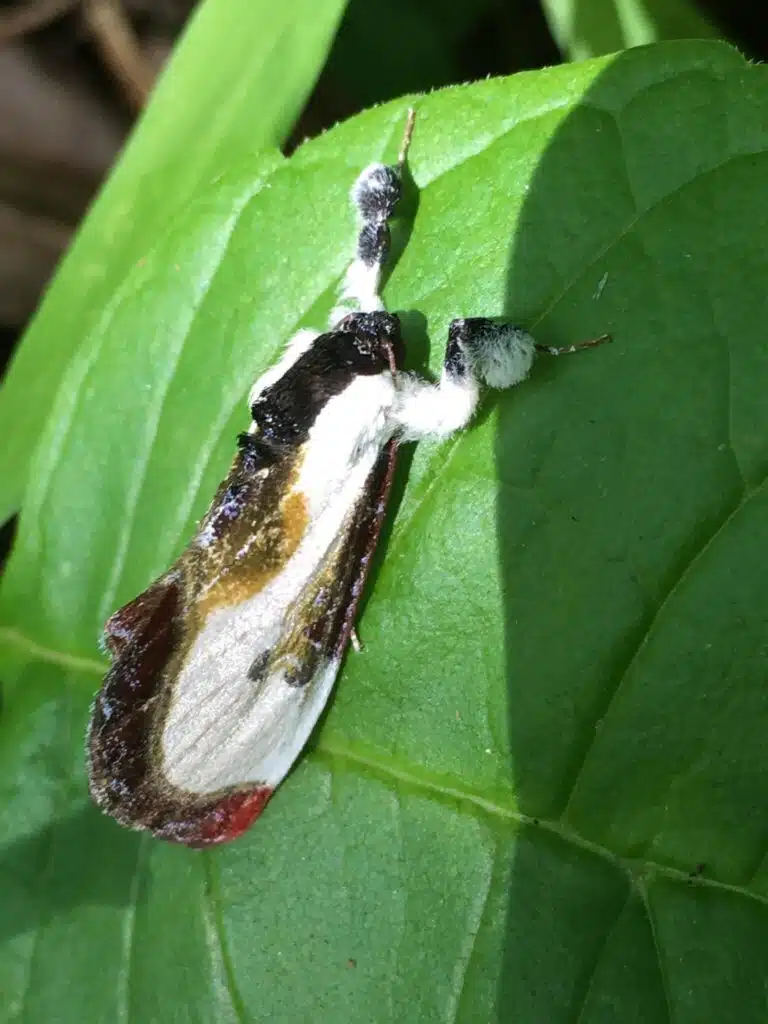
Beautiful Wood-Nymph moths (Eudryas grata) are known to use mimicry tactics to avoid predation.
The species is among the few moths that mimic bird droppings by coloring and positioning the wings to avoid predation.
Wasps and birds avoid these moths as a result.
The rolled wings of the species in a resting position make them resemble the shape of bird droppings.
Beautiful Wood-Nymphs have a combination of white, brown, black, and yellow colors in a resting position.
While they mimic bird droppings, white is still the dominant color of the wings.
These moths have white forewings with brown margins and brown bands across the upper margins.
The hindwings have a pale yellow color with brown margins.
You can see these moths all across the Eastern part of the US where they have multiple plant hosts.
Grapes and buttonbush are among the host plants of the species. Caterpillars grow on these plants.
5. Rustic Sphinx
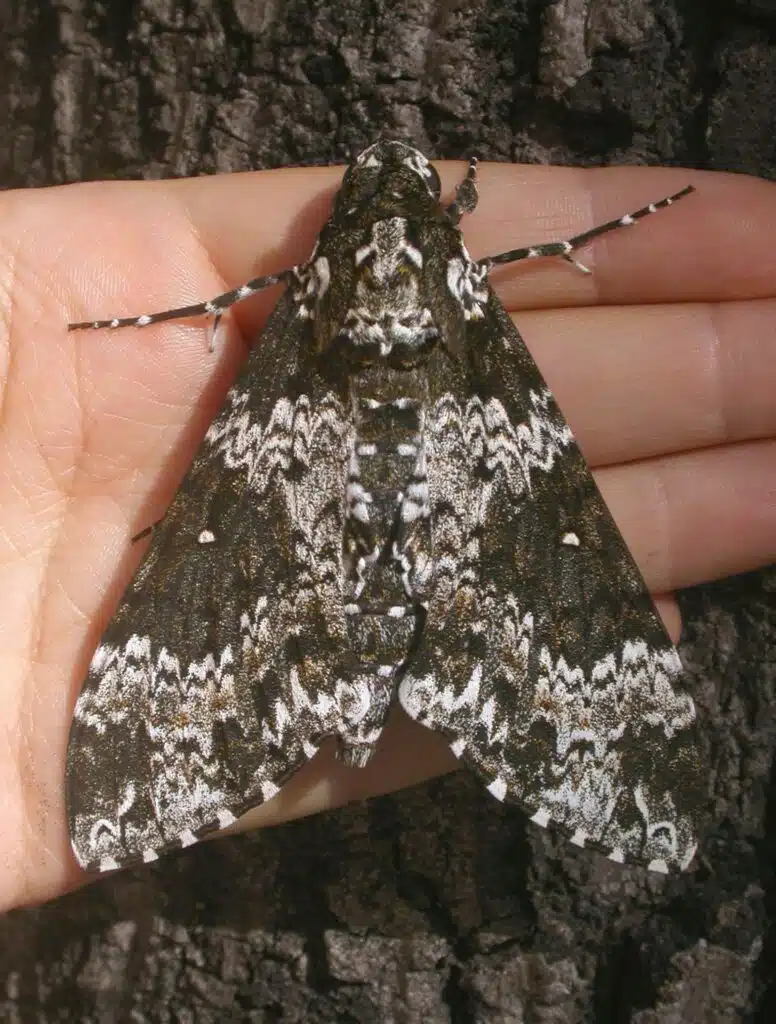
Rustic Sphinx moths (Manduca rustica) get their name from the sphinx position its caterpillars are sometimes found in.
These moths have a black and white color with gray shades as tertiary marks across the wings.
Found in Southeastern US including Florida, this moth species is found in all states through to Texas.
The caterpillar of the species is easier to spot since it grows on decorative plants.
Adult Rustic Sphinx moths are further seen on various plants for nectar. They have a positive pollination role, albeit not to an extended degree.
Adults of the species are out for nectar both during the day and during the night.
The role of these moths is slowly changing according to the scientific community.
From a beneficial moth, Rustic Sphinx moths can be seen as detrimental in certain areas as their caterpillars have been reported on olives.
The population of Rustic Moths isn’t increasing by considerable percentages as the species is one of the preferred prey for various predatory black wasps.
6. Hebrew Moth
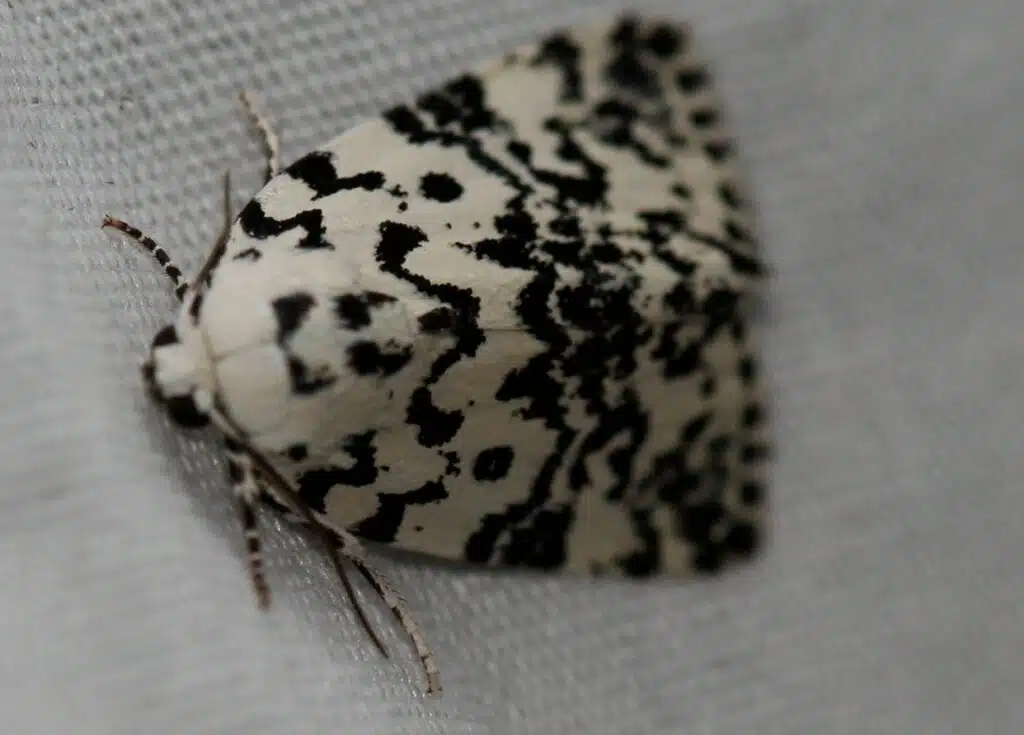
Hebrew moths (Polygrammate hebraeicum) have a wingspan of up to 39mm. Its wings are entirely covered by black patterns.
White is the base color of the wings. Black patterns, stripes, and lines are characteristic of the species.
The legs of the moths are white, resembling the white ventral color of the species. Its antennae are black and white.
Multiple patterns are seen on the upper hindwings compared to other areas of the wings.
The larvae of the species is a known pest of gum trees.
7. Carpenterworm Moth
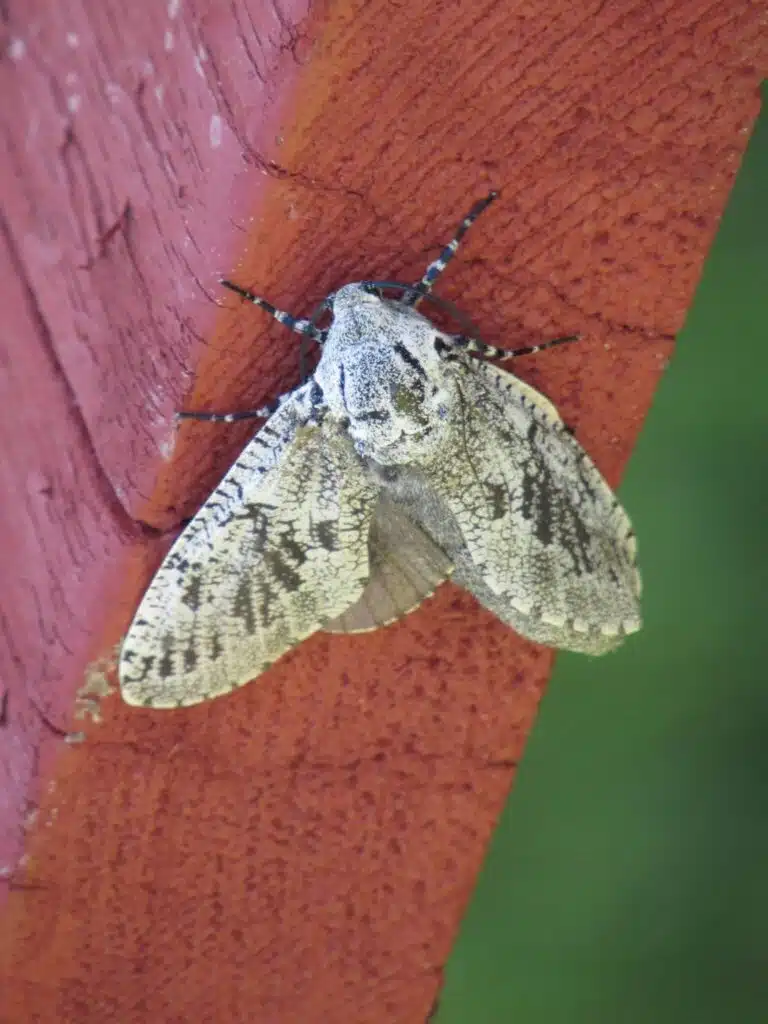
Carpetworm moths (Prionoxystus robiniae) are a species of black, white, and gray moths that are known native pests.
The species has a gray base color with white and black marks that aim to make it resemble tree bark.
The result is that Carpetworm moths have a coloring that makes them difficult to spot whenever they rest on tree bark.
Apart from avoiding detection, moths of this genus also prefer tree bark for resting as they lay eggs on trees.
The larvae of the species grow in hardwood trees. Furthermore, the Carpetworm moth larvae dig tunnels into wood.
While these small tunnels may not kill trees, they decrease the economic value of lumber.
Some of the most affected tree species are oak and poplar host trees. Willow is also impacted by the larvae of the Carpetworm moth.
Ash trees in woodlands are highly impacted by the moth which benefits from camouflaging capacity which allows it to lays a large number of eggs while avoiding predators.
8. Leconte’s Haploa Moth
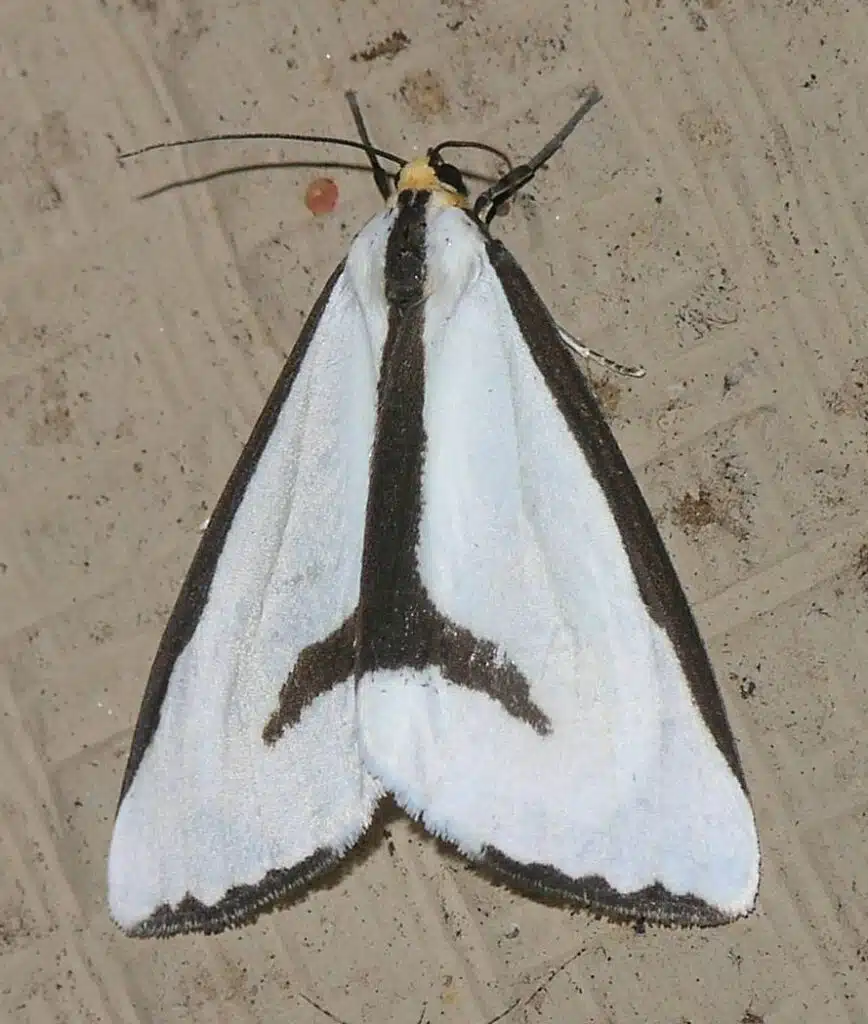
Leconte’s Haploa moths (Haploa lecontei) have a detrimental role on trees, but not to the extent of Carpetworm moths.
These moths are found in different color patterns, all based on white and black combinations.
White is the base color of the wings. A single central stripe, multiple stripes, or other black patterns can further be distinguished by the species depending on gender and region.
Moths of this genus are frequently seen in white color with a central strip that expands to the outer edges of the wings.
Leconte’s Haploa moths are further differentiated in black wing patterns according to the host trees they inhabit.
Apple and peach are its most common hosts. Smaller shrubs such as blueberry shrubs are also a host genus for the moth.
9. Buck Moth
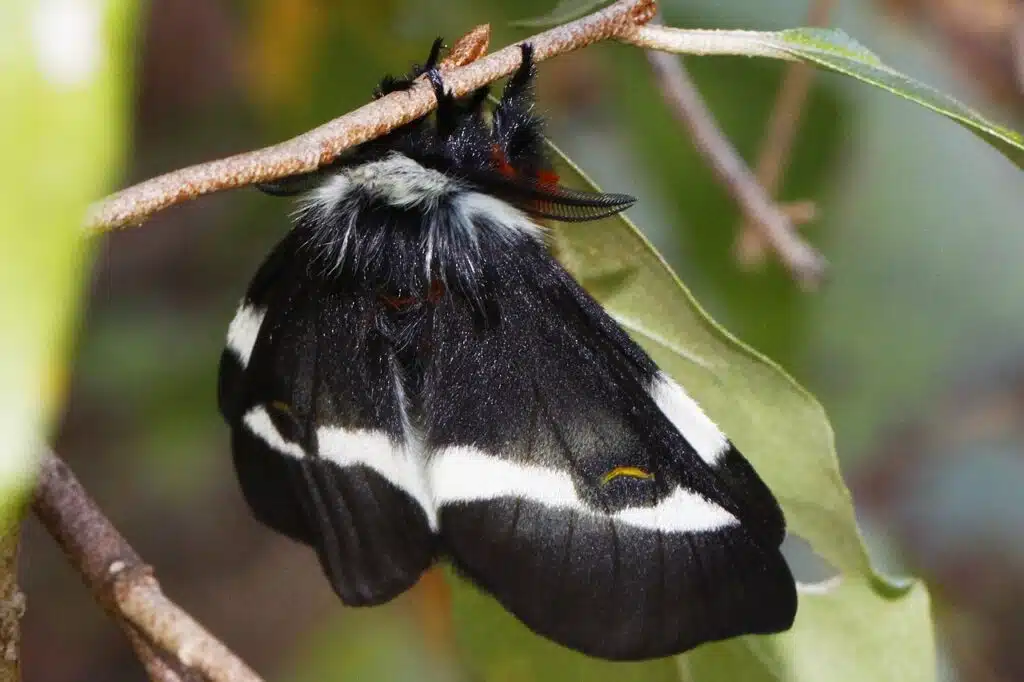
Buck moths (Hemileuca maia) have a base brown and black color with wide white bands.
The body of the species is mostly black with long black hairs on the upper body and white and orange hairs on the lower body.
The wings of the species also show 2 eyespots each. These eyespots are black and brown with a yellow central section.
The Buck moth is one of the multiple invasive moth species in North America also considered a pest of hardwood trees.
Oak trees are among the most affected species by the larvae of Buck moths.
Eggs are laid in clusters and they then turn to larvae which feed on live oaks.
10. Pearly Wood-Nymph
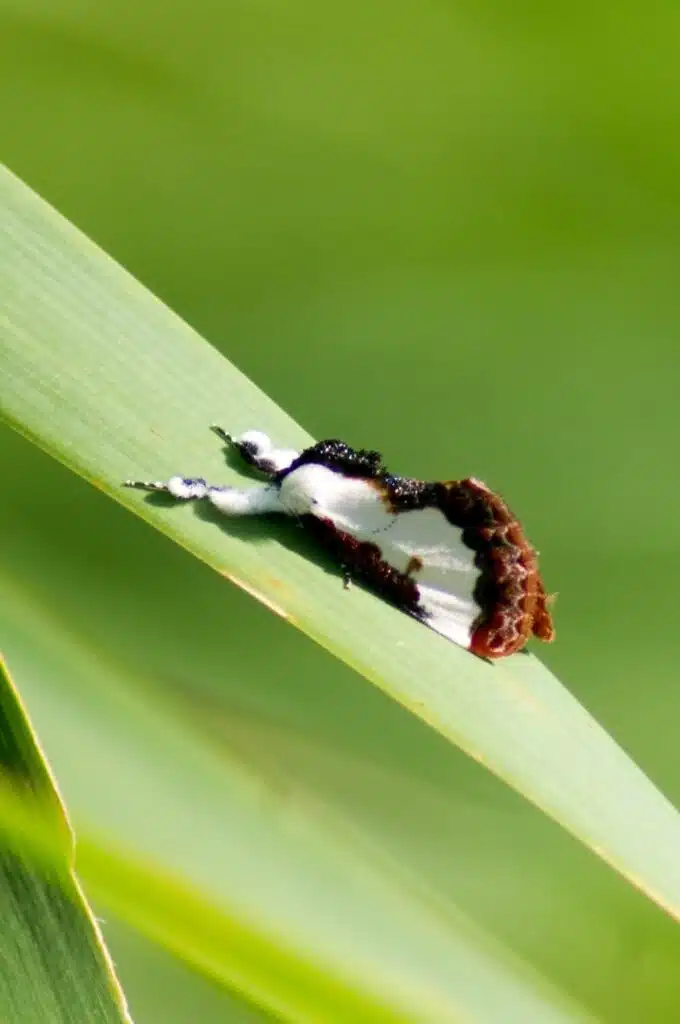
Pearly Wood-Nymphs (Eudryas unio) are US and Canadian native species. They grow to a wingspan of up to 35mm.
Moths of this genus are known for their colorful wings.
There’s a difference between the upper wings and the hindwings of the species when it comes to coloring and patterns.
White dominates the color of the forewings while yellow dominates the color of the hindwings.
Black and brown borders are specific to the forewings.
The hindwings of the species also have margins but with a lighter shade.
This species is among the few moths with a widespread presence both on the West and on the East Coast.
11. White-striped Black
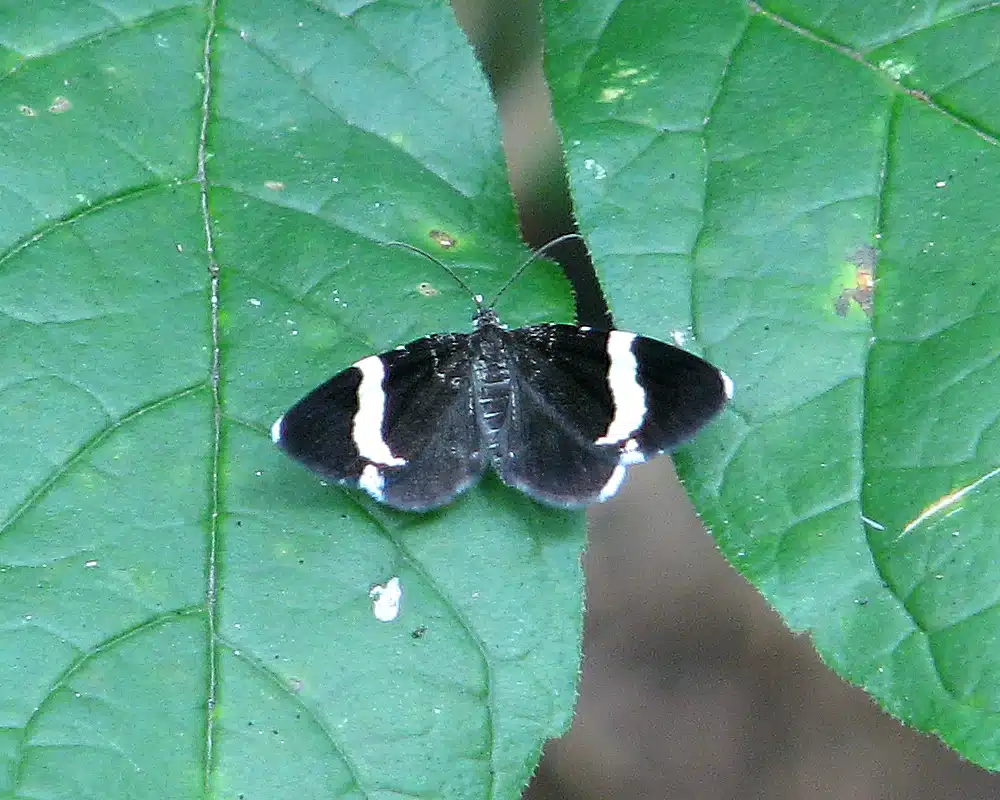
White-striped Black moths (Trichodezia albovittata) get their name from their all-black coloring with just a couple of wide white bands.
The species has short white margins and a black body that shows white bands.
Its antennae are a combination of black and white bands.
With a wingspan of up to 25mm, this is one of the most common small to medium moths with widespread North American distribution.
It lives in most states and its habitat expands into Canada and Alaska.
The flight season of the species varies considerably from one state to another. However, most White-Striped Black moths emerge by April.
Their flight season continues from August-September.
This species is considered a pest as larvae. The White-Striped Black larvae feed on purple flowers such as jewelweed.
12. Little White Lichen Moth
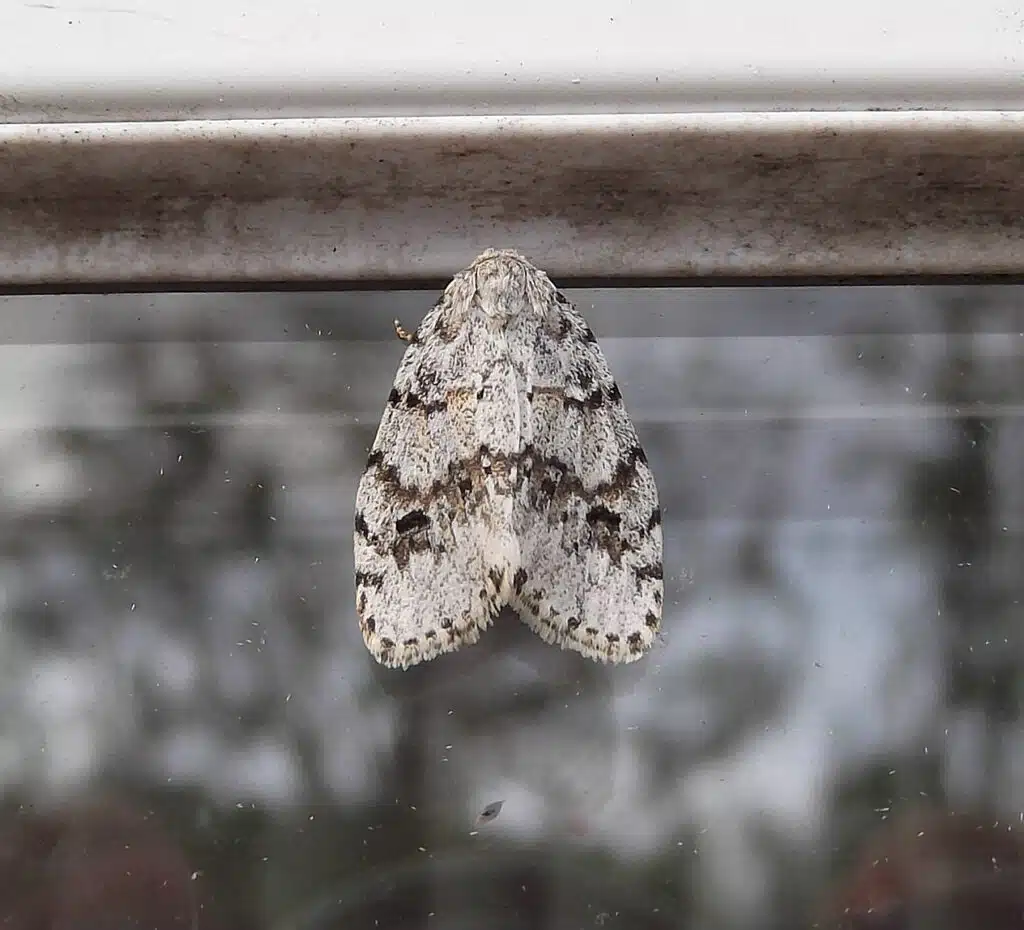
Black, white, and gray colors are specific to the Little White Lichen moth (Clemensia albata).
Its forewings are mostly off-white with brown and black spots and margins.
The entire area of the forewings is covered in spots and marks as opposed to the plain hindwings. The body of the species has the same colors as its forewings.
The hindwings are white and gray with faint brown or black margins.
Moths of this genus are among the species that feed on lichens and algae.
The species is easier to spot in woodlands where the moths feed on various trees that host lichens. Conifers or trees at high elevations are more likely to be seen as a host for the species.
13. Laugher Moth
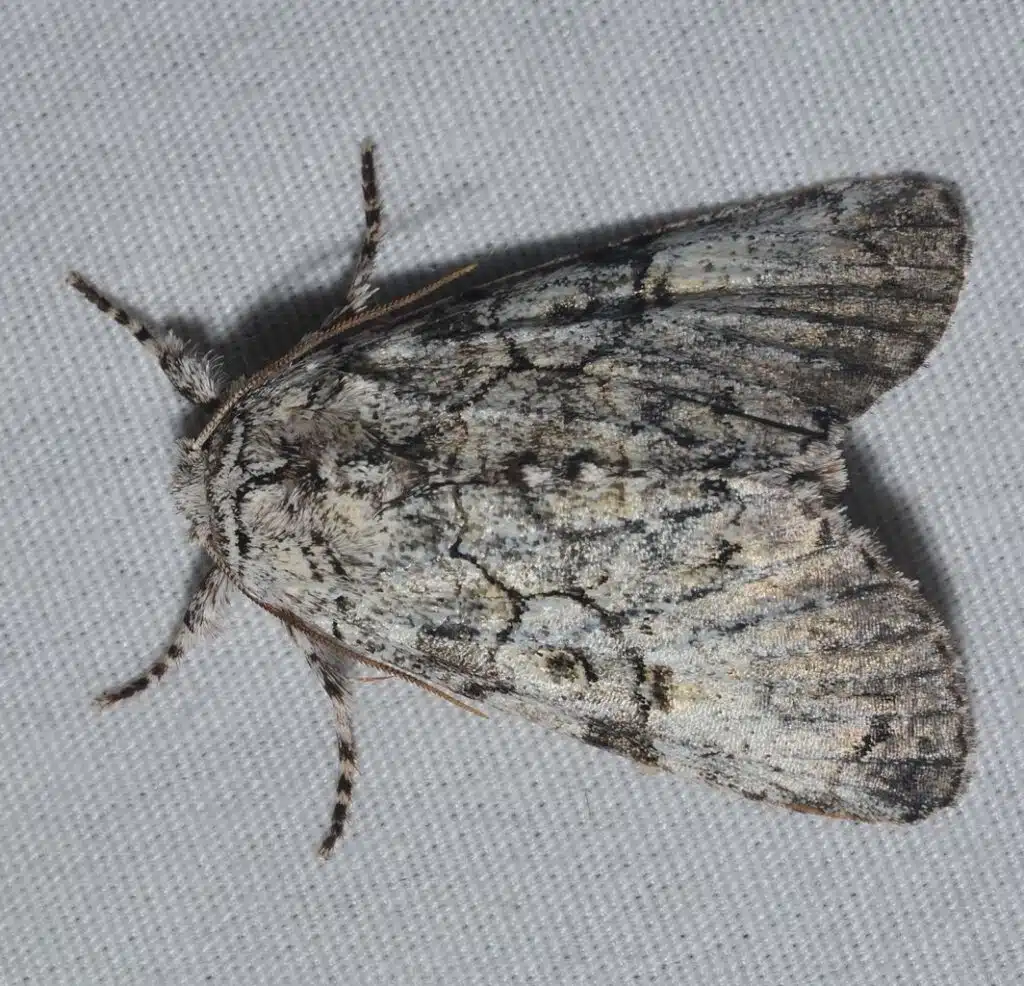
Laugher moths (Charadra deridens) are native to most US states and Canada.
This species has a wingspan of up to 48mm and it stands out with different colors and patterns from the forewings to the hindwings.
Black and white colors and patterns are seen across its forewings. Gray spots and eyespots are further distinguished on their forewings.
Its body is also black, white, and gray.
The hindwings of the species are mostly white with a narrow gray band.
Moths of this genus only show their hindwings when flying.
Otherwise, they use the coloring of the forewings to camouflage themselves on tree bark.
Hardwood trees are host species for the larvae of Laugher moths. Maple, oak, and birch are among the multiple host trees for their larvae.
14. American Oak Beauty
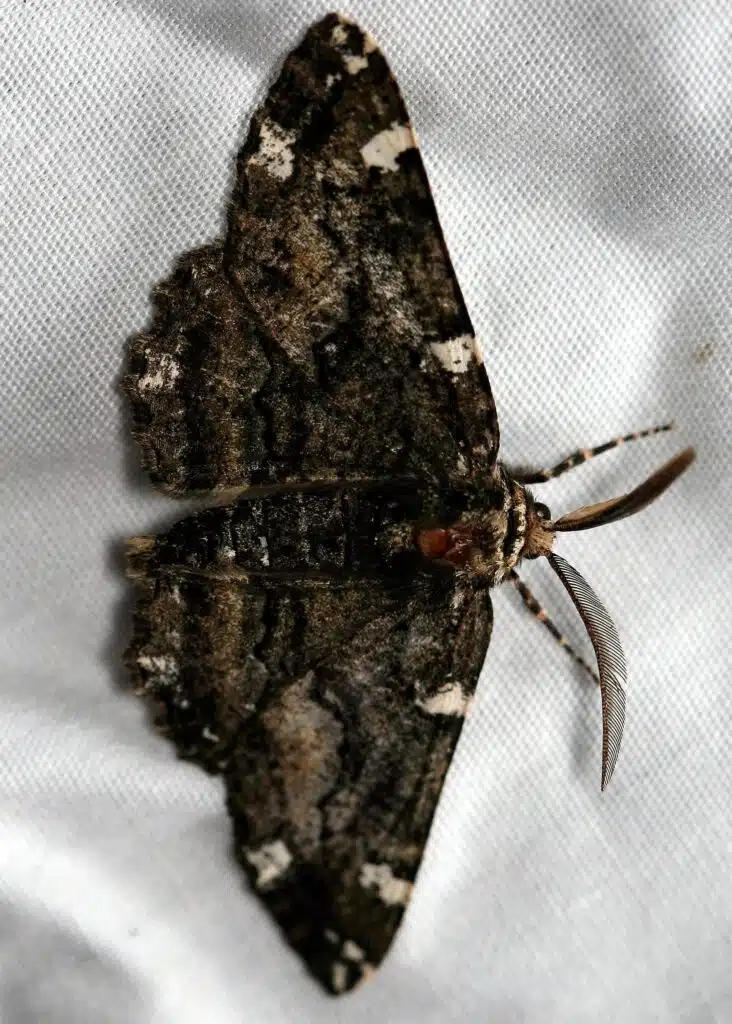
American Oak Beauty moths (Phaeoura quernaria) are a native species mostly seen around woodlands.
Its name implies oak is its host tree but there are many other trees the moths live on. Birches are among its favorites.
American Oak Beauty moths are named after their black and white colors and patterns that decorate the wings.
As a large moth, its wingspan can sometimes measure more than 50mm.
American Oak Beauty moths have mostly black wings with white and black patterns across the forewings and the hindwings.
The body of the species is also black and white.
This moth species can be seen throughout the year in North America as it has a long flight season. The first moths of the species appear in February with a flight season that extends to October.
15. Dot-lined White
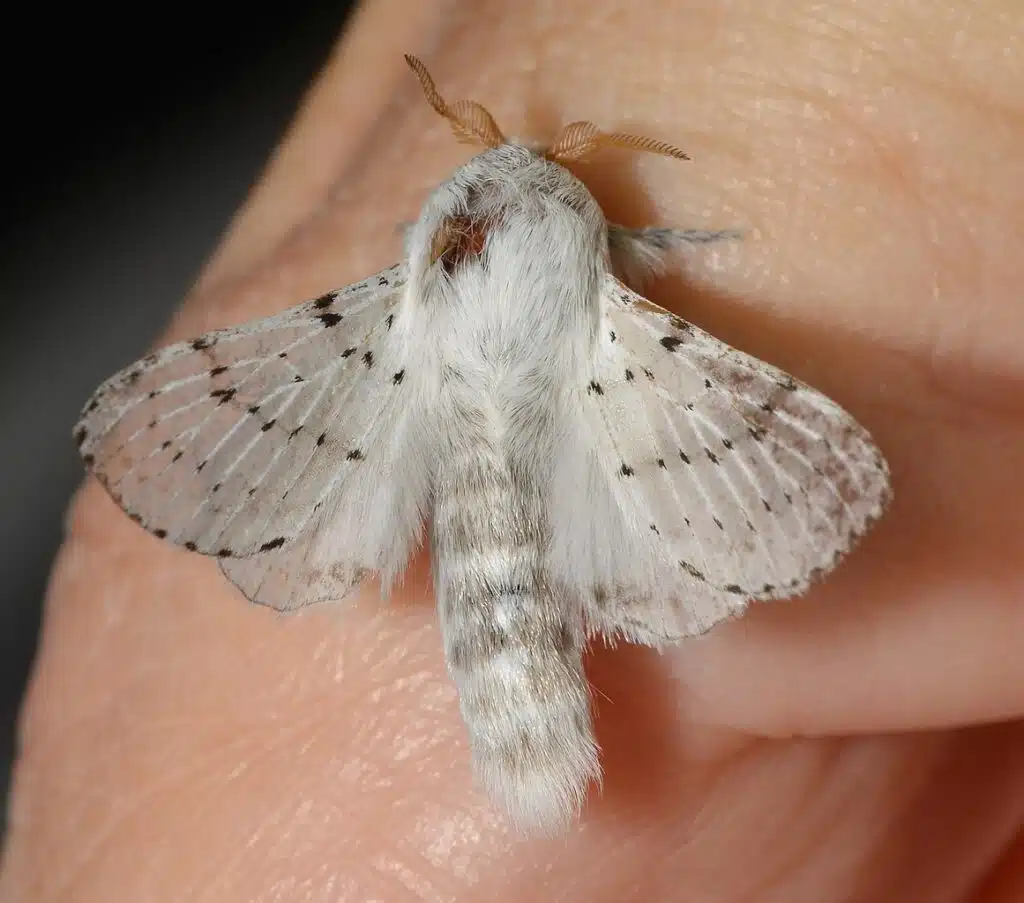
Dot-lined White moths (Artace cribrarius) are mostly white species moths with distinct coloring.
Its wings are pure white with additional white veins that also show black dots and tiny black with additional white veins that also show black dots and tiny black marks.
The species is believed to mimic various small birds in the Eastern parts of the US through its wing colors.
The body of the species is pure white.
You can find the Dot-lined White across various woodlands in the US, mainly in oak woodlands.
The Dot-lined White appears late in the season since it lives in the Northern states. It emerges in June.
16. Police Car Moth
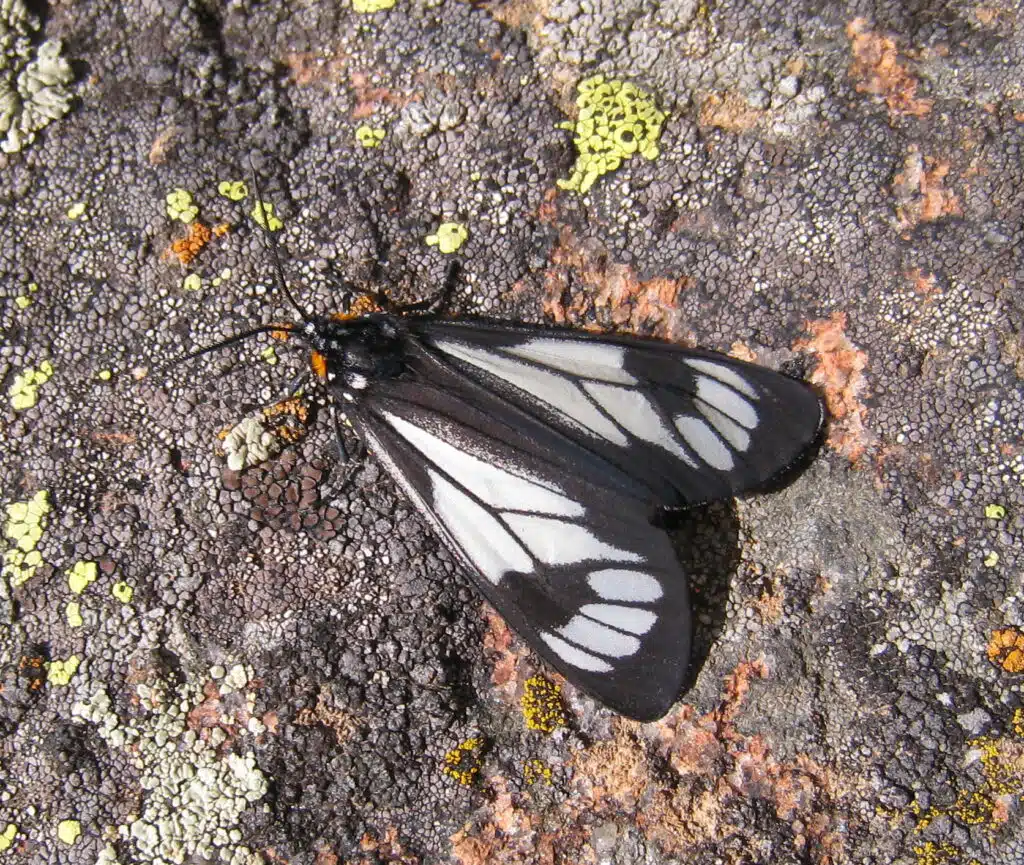
Police Car moths (Gnophaela vermiculata) are native to Western North America and other parts of the world.
Police Car moths are black and white like adults and yellow like caterpillars.
The adult moth has white wings with visible black veins and thick black margins.
The hindwings are separated by the forewings by black bands along the wings as well.
Multiple generations of Police Car moths are born each year. 5 broods are specific to North America per year.
This species is among the larger native black and white moths. Police Car moths grow to a wingspan of up to 54mm.
17. Large Tolype Moth
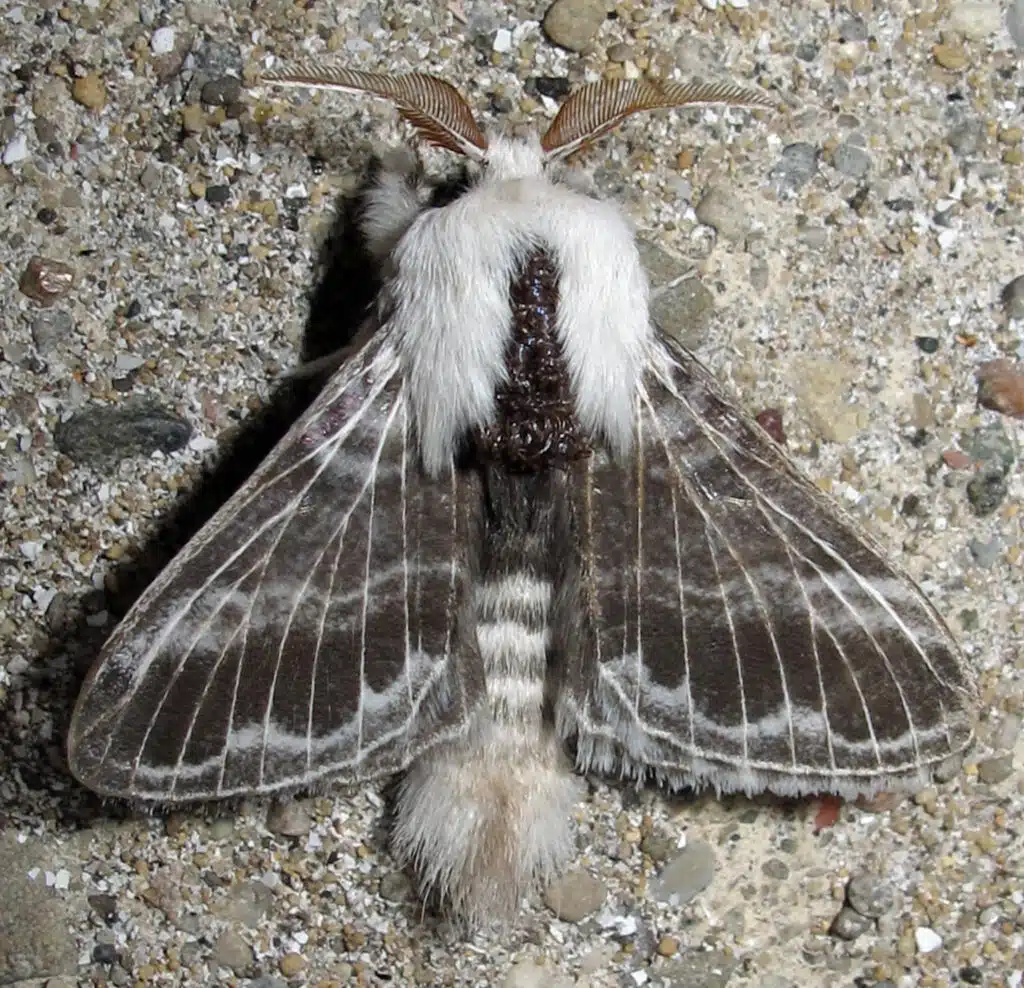
Large Tolype moths (Tolype velleda) have black, white, and gray coloring.
This moth is native to almost all Eastern US states. This species stands out with its coloring. The upper body has dual black and white nuances.
Its wings show a combination of black, white, and gray-dominant areas. The inner wings are gray with vine veins.
Black marks are specific to the outer wings of the moth.
The margins of its wings are also black with a white border.
The Large Tolype moth hurts decorative trees and fruit trees. This is a species that impacts oak trees, birch, and elm trees.
It also impacts plum and peach trees.
Caterpillars are the ones responsible for tree defoliation. Large populations of these caterpillars can even kill trees that they use for food.
18. Small Bird-dropping Moth
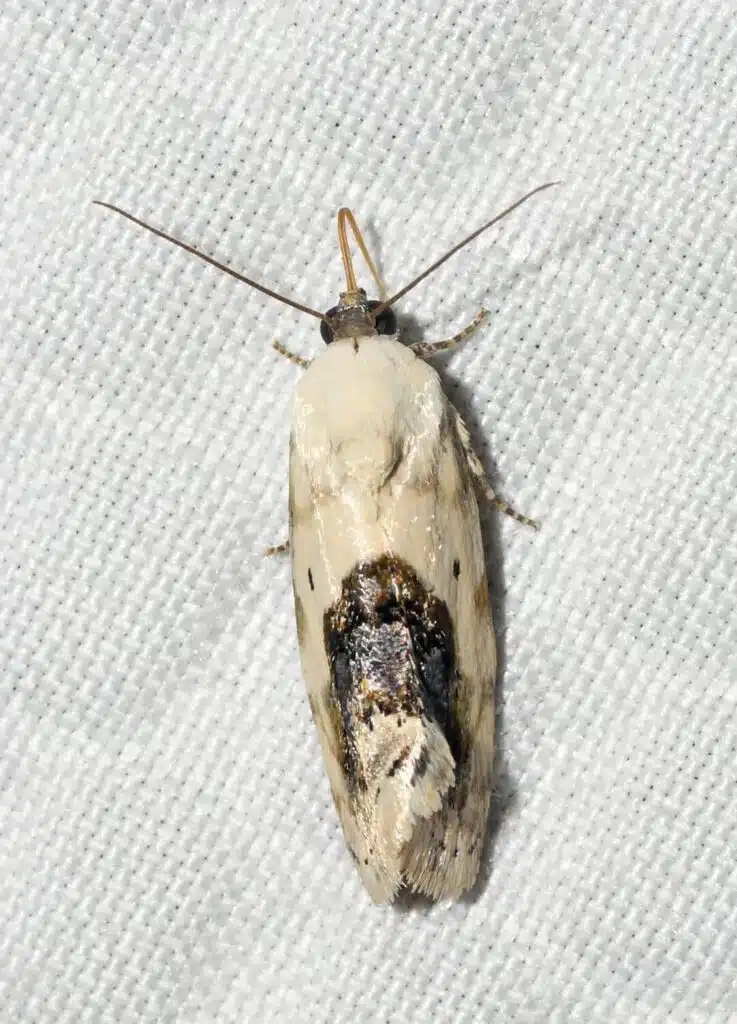
Small Bird-dropping moths (Ponometia erastrioides) are white, brown, and black.
These moths mimic bird droppings to appear distasteful to their predators.
This mimicry is achieved through both colors and shapes. Small Bird-dropping moths keep their wings wrapped around their body in a cylindrical shape to look more like droppings.
The coloring of the wings is irregular and highly specific to most types of moths that mimic bird droppings.
The larvae of the Small Bird-dropping moth feed on ambrosia before changing their diet.
They then turn into adults with a wingspan of up to 20mm.
19. White-tipped Black
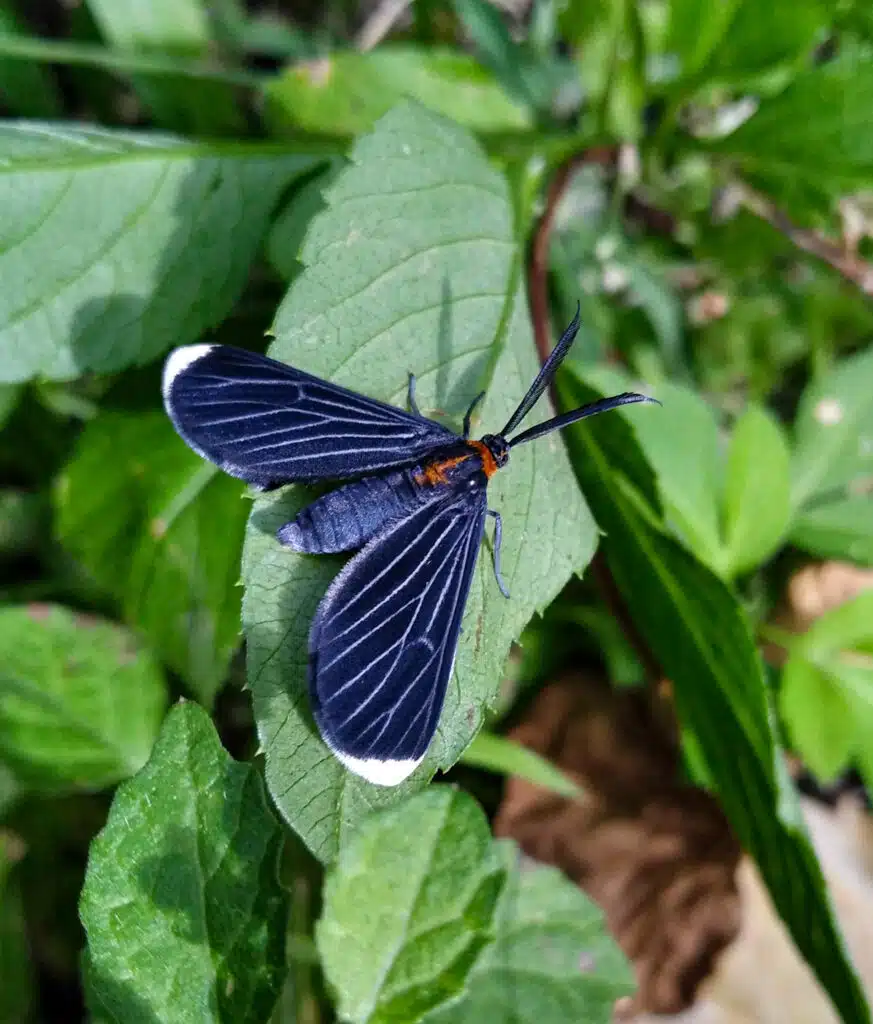
The White-tipped Black moth (Melanchroia chephise) is found in the extreme South of the US.
This species stands out with its dark body with just a few bright marks.
Its wings are black with white veins and white marks on the edges of the wings.
The upper body has a red-brown color. This vivid color is also seen on the ventral side of the body.
Moths from the White-tipped Black species grow to a size of up to 33mm. They fly late in the season as they inhabit warm areas such as Southern Texas and Southern Arizona.
This species is active until December.
20. Common Spring Moth
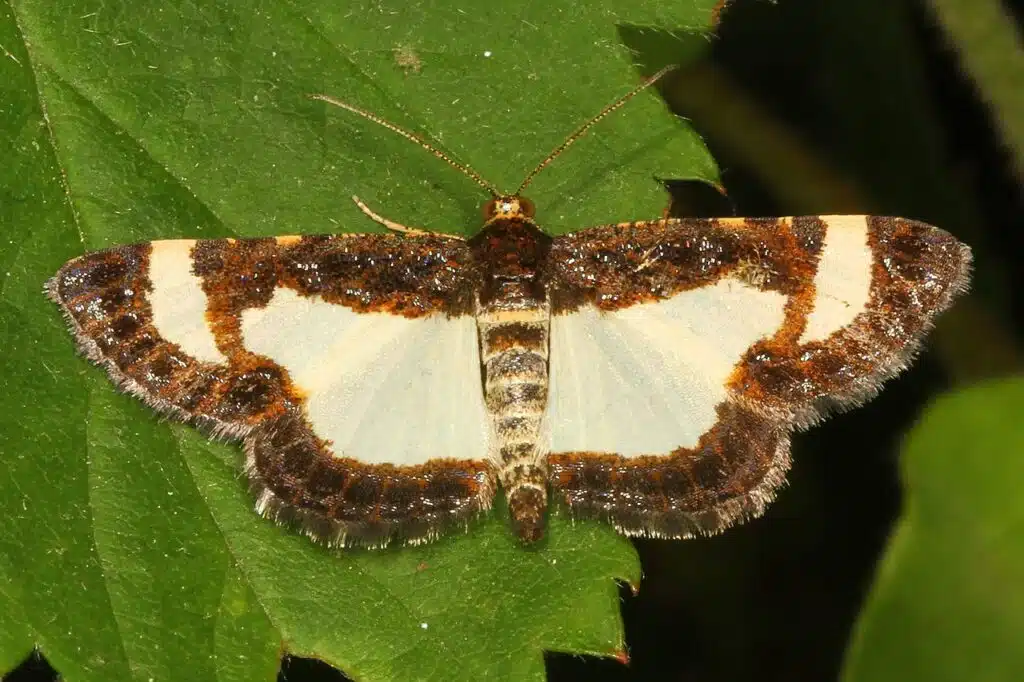
Common Spring moths (Heliomata cycladata) are a North American native species seen on black locusts.
This species has white and black coloring with brown and yellow marks and little variations within the species.
Common Spring moths have white wings. This is a type of pure white and not off-white as with most other moths.
The wings have black borders with brown and yellow marks.
Some of these colors are also seen on its body which is also mostly dark.
2 yellow spots are further visible on the head of the species. The antennae are black and yellow.
Common Spring moths can further be differentiated from other white moths with black margins by the white band seen across the central area of its body.
21. Confused Haploa Moth
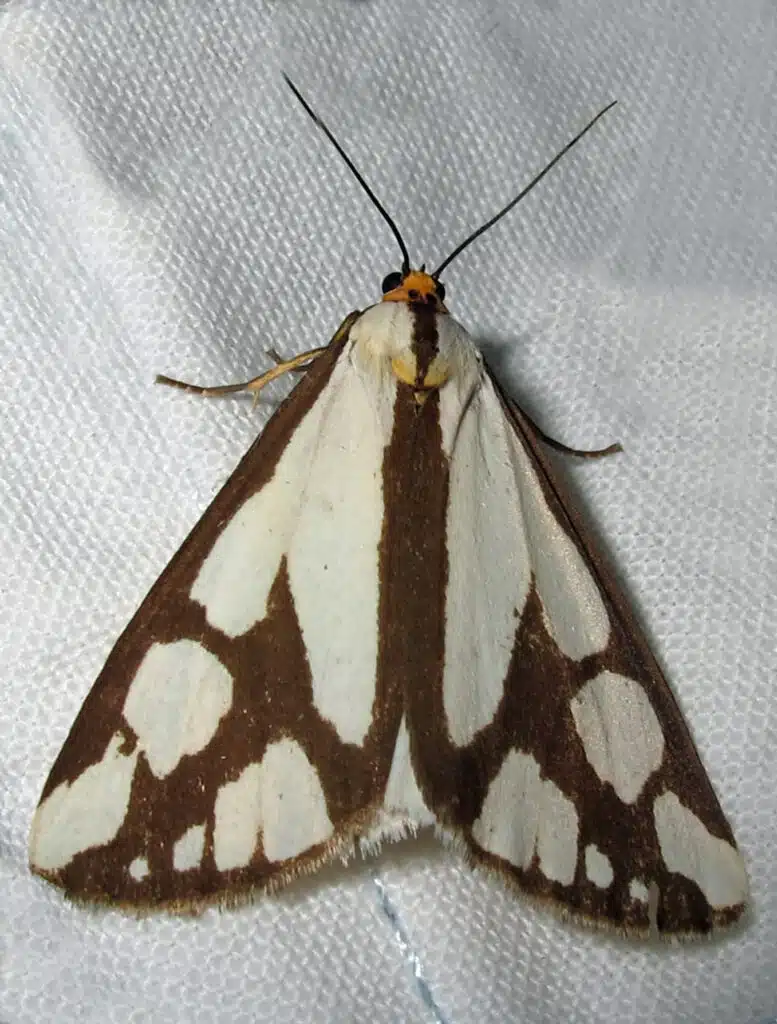
Confused Haploa moths (Haploa confusa) are mostly black and white on the forewings and white on the hindwings.
The white base color is specific to the forewings which also have black margins and wide black veins.
These moths also have white hindwings.
Moths of this genus evolve from mostly black caterpillars.
Confused Haploa moths are seen across various habitats where they can find dog tongue flowers.
These are small flowers that have blue, red, or purple colors and are used as a host by the moth.
22. Zebra Conchylodes Moth
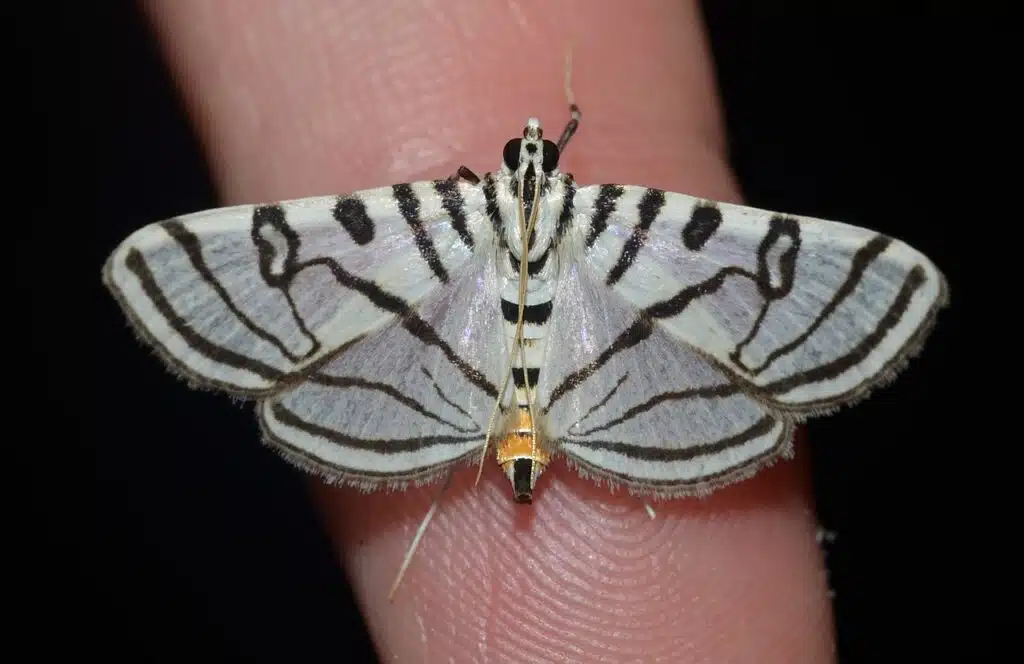
White colors with alternating black stripes are specific to the Zebra Conchylodes moth (Conchylodes ovulalis).
This is a species that grows to an average size between 23 and 30mm.
Its wings are mostly white but the black stripes across the wings are what inspire the name of the species.
The white wings of the moths tend to have a sheen in direct sunlight which might make them look blue or purple. which might make them look blue or purple.
Moths of this genus are found in Southern Florida and Southern Arizona. But they are present in vast territories across Central America and South America.
Zebra Conchylodes moth has a flight season that expands to September.
Some of the best areas of Florida and Arizona to see these moths are habitats rich in asters, and their host plants.
23. Confused Meganola Moth
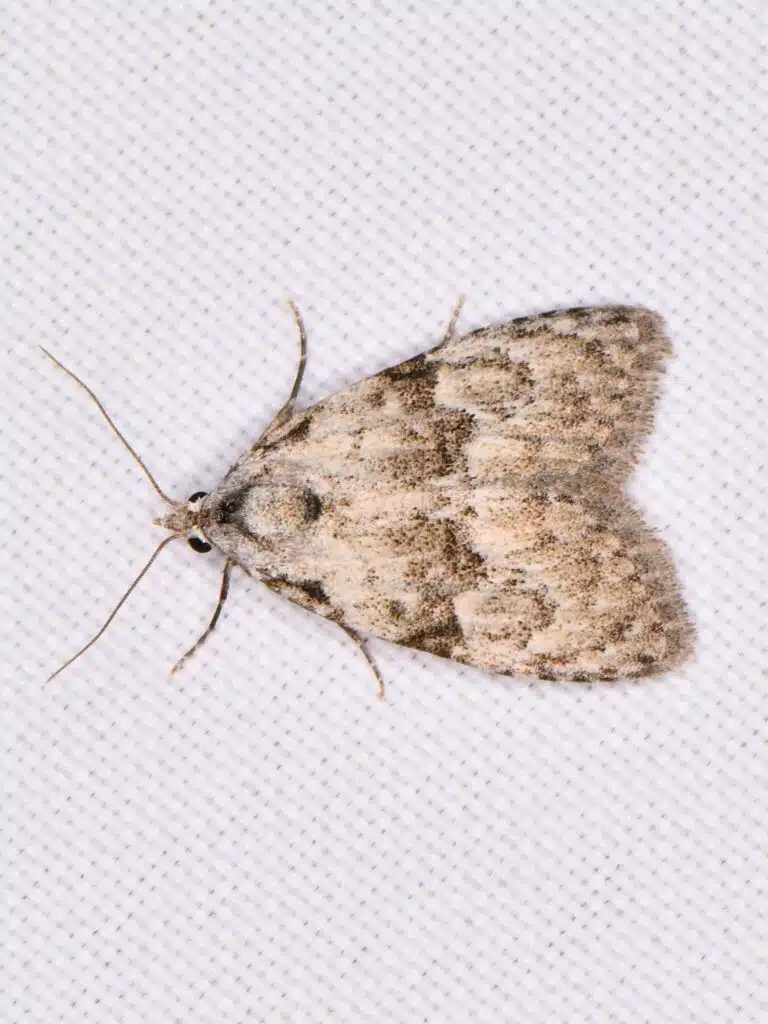
The Confused Meganola moth (Meganola minuscula) has a white, gray, and black molted color. This species is small as its wingspan can measure a maximum length between 14 and 24mm.
Native to North America and Mexico, the moth is also known as the Moth of 3 scales as it has 3 black marks on its forewings.
Confused Meganola moths appear in at least one brood per year in the Northern climates and multiple yearly broods in the South.
This species is a known problem for many trees including oak and willow. It lays eggs on these trees which later grow into larvae.
Its larvae eat these trees. While insignificant on a large scale, the damage of its larvae causes economic losses in the lumber industry.
24. Schlaeger’s Fruitworm Moth
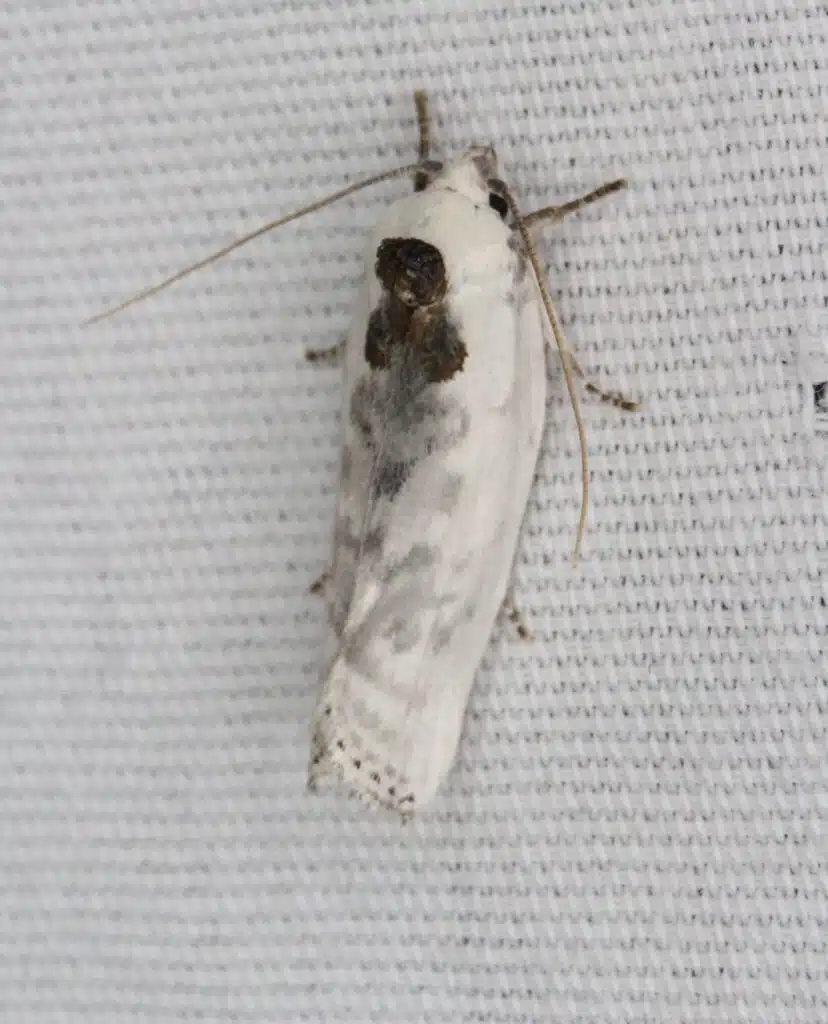
White oaks are the main host species of these moths. Larve of the Schlaeger’s Fruitworm moths (Antaeotricha schlaegeri) is also seen on other fruit-bearing trees.
These moths are known for their mimicry habits. They have the shape and color of bird droppings.
White is a dominant color across the wings, together with brown and black.
These white moths are also known for having gray marks across the forewings that they only show when resting their wings together.
Like most other white and black moths, Eastern US territories suit the species the most.
They are seen across all states from Ohio to Texas.
Moths of this genus are active until August.
25. White Stripe-backed Moth
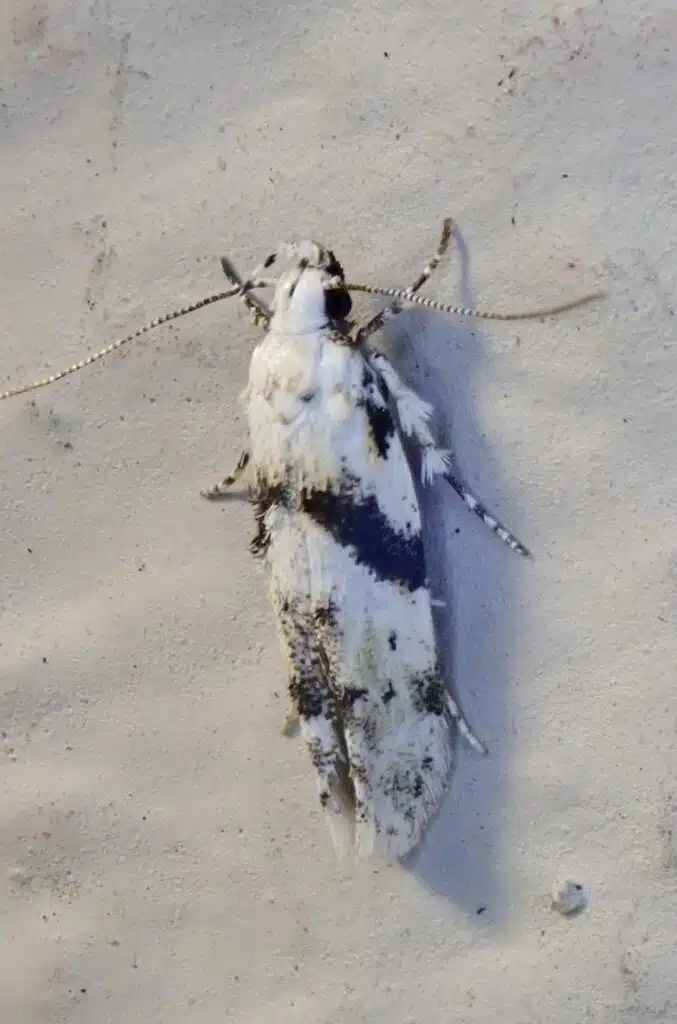
This moth species (Arogalea cristifasciella) is native to the US and Canada.
It has a mostly white color that makes it stand out in its habitat.
The wings of the species are mostly white. Black lines are seen across its wings.
Brown margins are seen on some of the black lines of the species.
Its legs have a coloring made from a combination of black and white.
Oak trees are among the most common hosts for the White Stripe-backed moth. These trees show clear infestation signs whenever their leaves start to darken.
26. Spotted Peppergrass Moth
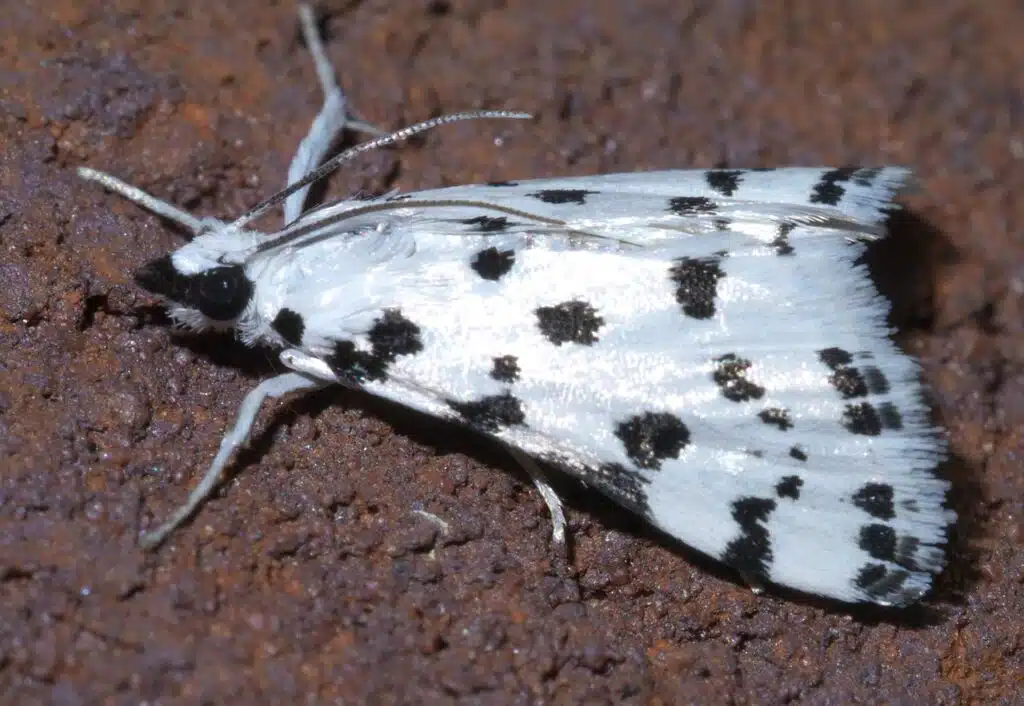
Spotted Peppergrass moths (Eustixia pupula) have a white base color with black spots.
This species is seen on peppercress, a small type of yellow host plant.
Spotter Peppergrass moths grow to a maximum wingspan of 17mm.
Similar wingspan and coloring can sometimes lead to incorrect species identification as there are other similar moths in the US.
Spotted Peppergrass moths stand out with an additional brown spot behind their heads.
27. White-spotted Sable
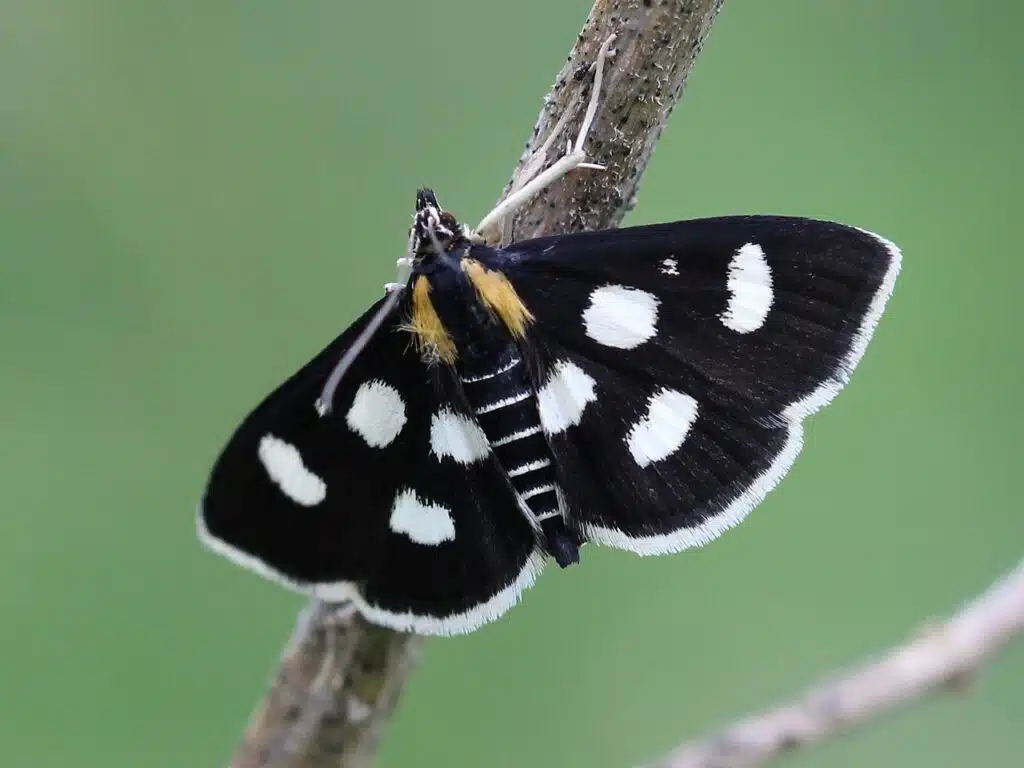
White-spotted Sable (Anania funebris) are common across a few continents. The species is mostly seen across goldenrod fields next to woodlands.
The caterpillars of this genus are responsible for diminishing goldenrod habitats as they can kill their host plants while growing.
White-spotted Sable moths have black wings and a black body. Large white spots are visible across its wings.
These white spots are backed by fine white lines across its body.
Yellow or light brown hairs are further visible on the back of its head.
White-spotted Sable moths have a growing presence around the world. The flight pattern of the moth is what prevents them from being a regular target for predators.
These black and white moths fly with spinning movements which means a flying predator has a difficult time keeping up.
28. Harris’ Three-Spot
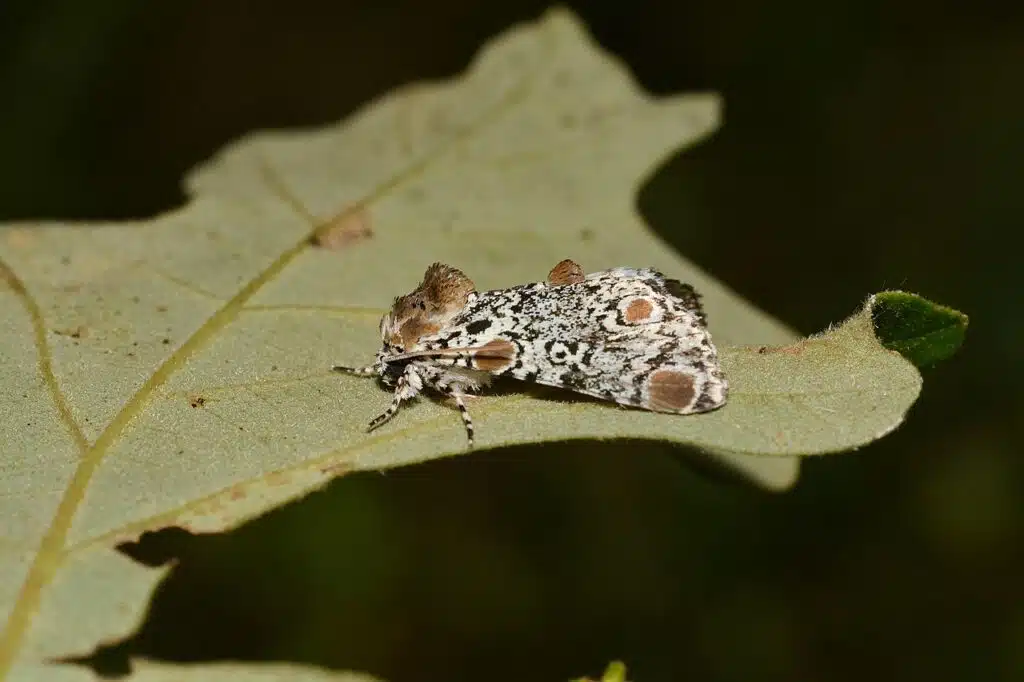
Moths of the Harris’ Three-spot family (Harrisimemna trisignata) are native to the US and parts of Southern Canada.
The black and white species is slightly larger than other black and white moths as it has a wingspan of up to 36mm.
From May to August, the Harris’ Three-Spot moth is a common sight on winterberry, honeysuckle, hardwood trees, and fruit-bearing trees.
You can identify the species by its black and white coloring and its separation of the wing colors.
The species has black and white patterns across the forewings. These forewings also show brown spots or brown eyespots with white margins.
The hindwings of the species are black with a thin black margin.
Its hindwings aren’t visible when the moth rests which means it has higher chances of improving camouflage on its shrub hosts when resting.
29. Redbud Leaffolder Moth
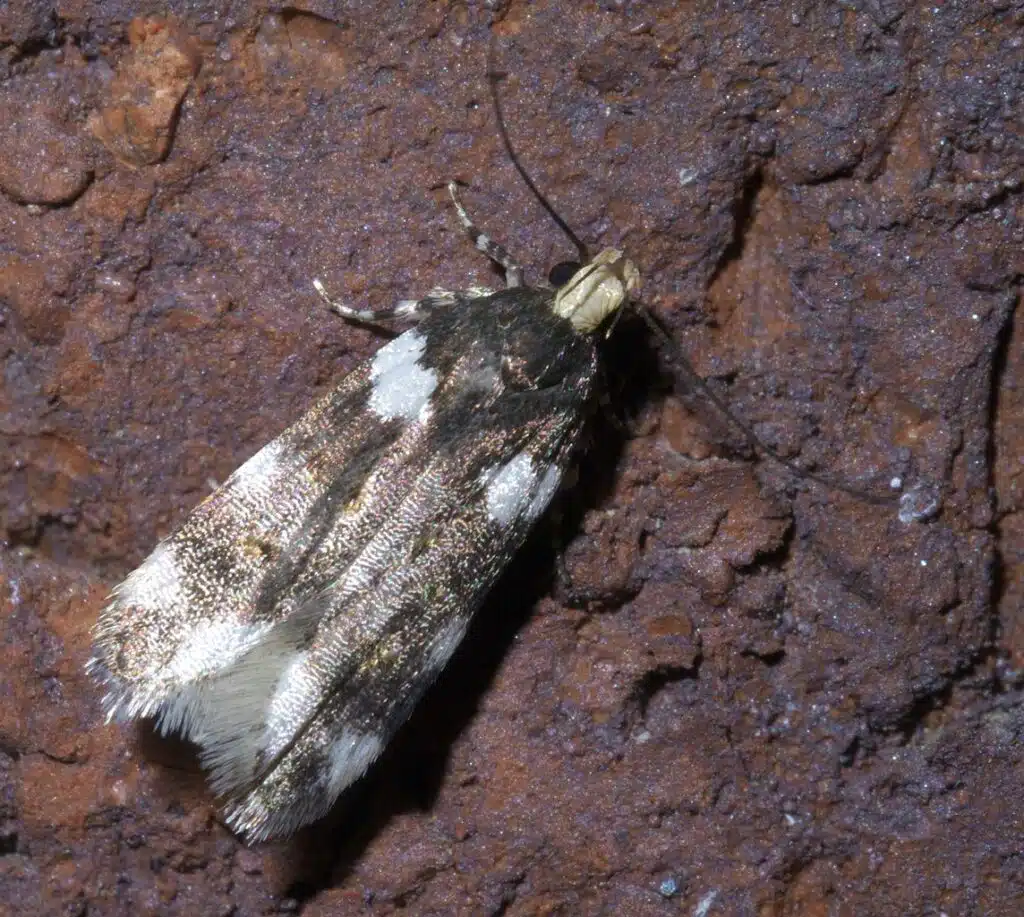
Redbud Leaffolder moths (Fascista cercerisella) are among the species that have a short flight season. These eastern US moths are only seen from April to October in all Eastern states including Maryland and Florida.
This species has black and white coloring. Its black wings show different types of white spots across.
The black coloring of the wings is also spotted with gray marks so that the species become even harder to see for predators on its host tree.
The adult moth resembles the caterpillar which is also black and white.
This species of caterpillars are seen as detrimental or highly detrimental, depending on their numbers on a host tree.
Eastern redbuds are the main host of the Redbud Leaffolder moths. Caterpillars of these moths can affect the trees at different life stages.
While these trees are small by nature, they are mostly affected in their first years of growth by the Redbud Leaffolder moth.
30. Melonworm Moth
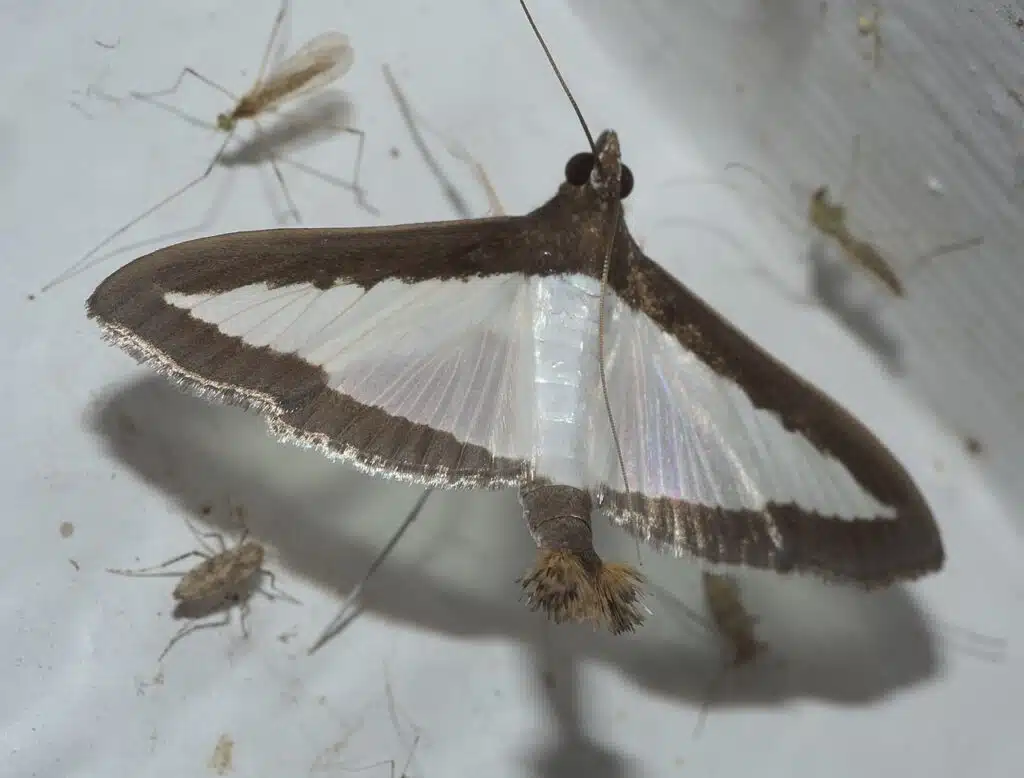
Melonworm moths (Diaphania hyalinata) are some of the most widespread melon pets in the Americas.
This species is difficult to spot due to its nocturnal activity when it comes out to mate or to look for food.
It has a bright white main color. Its wings tend to be iridescent in direct sunlight.
Melonworm moths are highly visible and almost shiny in direct sunlight and prefer to only come out at night.
The wings of the species have black margins while the body is also black. The ventral side of the wings and body are also almost completely white.
This species is known for attacking various types of summer and winter squash. They also eat the leaves of almost any other type of melon.
While they don’t eat the veins of the leaves, they can still defoliate entire rows of melons.
As a result, Melonworm moths are among the most common type of melon pests.
Insecticides are often used to limit their damage. Other methods are also considered for smaller-scale melon production.
Covering the melons with a fine mesh often provides the physical barrier needed to keep these moths away from squash and melon.
31. White Furcula Moth
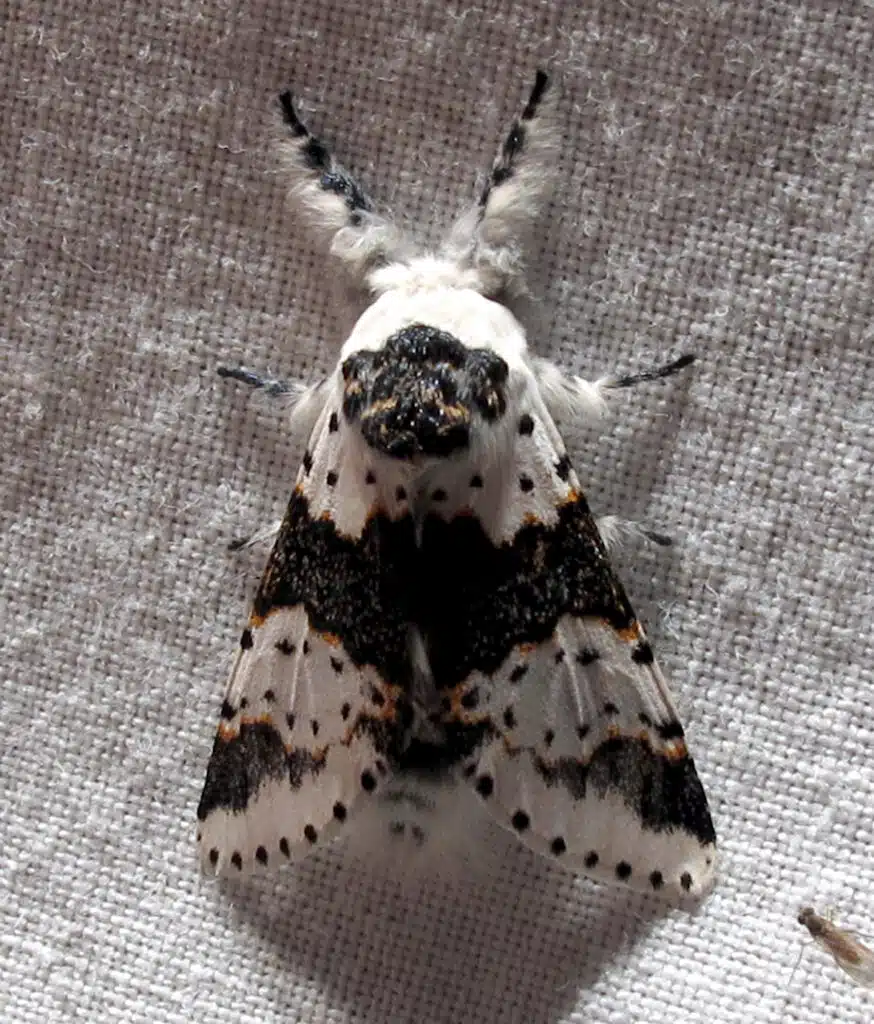
White Furcula moths (Furcula borealis) are only present in a few Southern states. These moths are seen across Florida and Texas.
Their role in the ecosystem is mainly detrimental as their larvae feed on the leaves of various host trees.
Black and white colors dominate the wings of the species with a few orange sections.
The wings are mainly white while black is only seen in the form of patterns and dots.
Tiny black dots border the wide black margins across the wings. Orange color is also seen in the form of narrow margins for the black sections of the wings.
The head of the species is mostly black but also covered in orange and white spots.
Moths of this genus have a hairy body that’s also mostly white.
The impact of the larvae is considerable when it comes to the White Furcula moth. The larvae of the genus feed on sweet cherry and aspen trees.
Willows are also a common host species in the absence of cherry trees to feed on.
32. Arge Moth
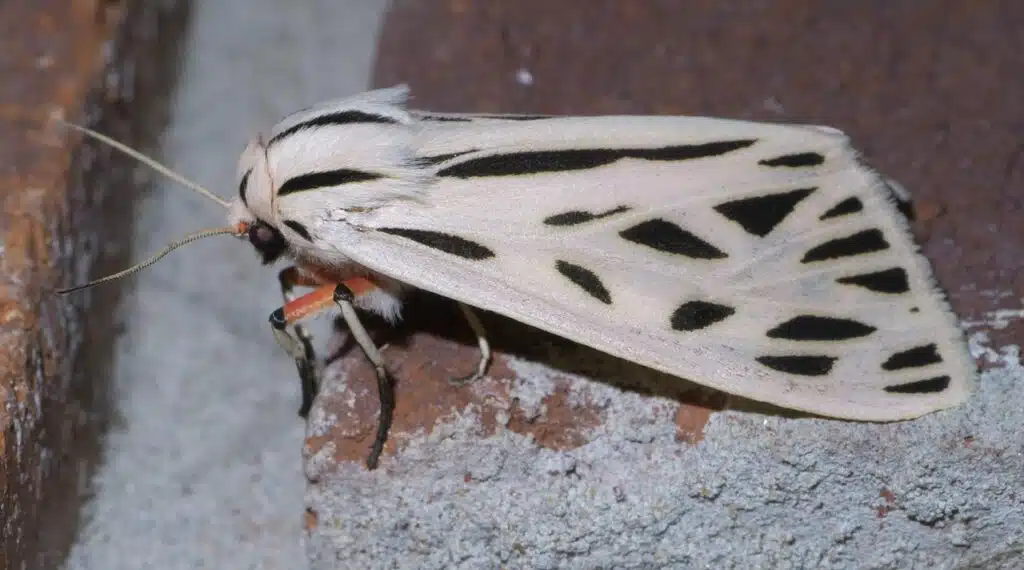
Arge moths (Apantesis arge) are among the most common species of moths across multiple crops and on prairies.
These moths have a base white color with multiple black stripes and marks across the wings. The lower part of the wings tends to have more black spots than stripes.
Wingspan varies considerably from one part of the country to another. This species can have a wingspan of just over 30mm as well as a wingspan of over 50mm in the case of the largest individuals.
The role of the moth in the ecosystem is detrimental. It feeds on various plants such as smartweed.
But it also consumes plants such as grape vines, sunflowers, and corn.
Its impact is seen on the leaves of these plants. The larvae of the moths defoliate many of their host plants.
Crop rotation, as well as insecticides, are some of the most common methods of controlling this moth and its caterpillars.
33. Wood Leopard Moth
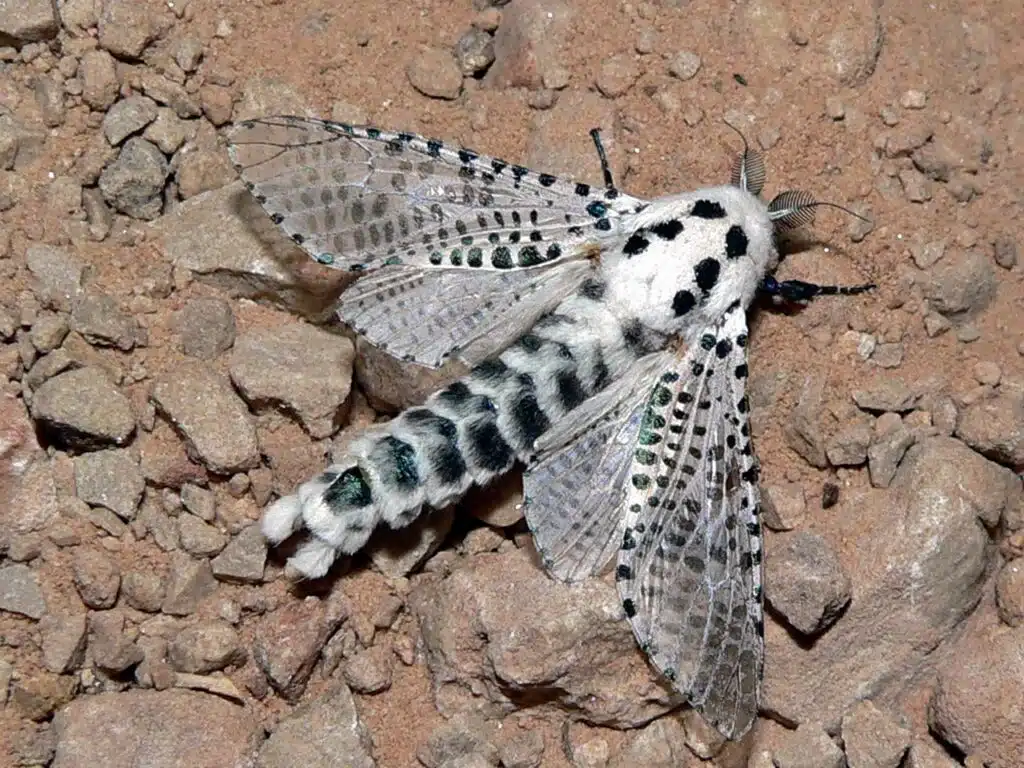
This moth species (Zeuzera pyrina) is native to Europe and Asia. It has mostly white with black spots across the wings.
The spots have an oval shape towards the head and a round shape towards the edges of the wings.
Additional black spots are further seen on the head of the species.
These moths can be large as they may reach a wingspan of more than 50mm.
The contrasting color of the species makes them an easy target for predators and this is why they like to live in woodlands.
However, these moths are also common in parks and gardens, depending on the tree species that inhabit.
Trees are used to lay eggs as well as food for the larvae of the species that can bore into trees.
The damage inflicted by the species is small for most trees and considerable for vulnerable species such as olive trees.
34. Reversed Haploa Moth
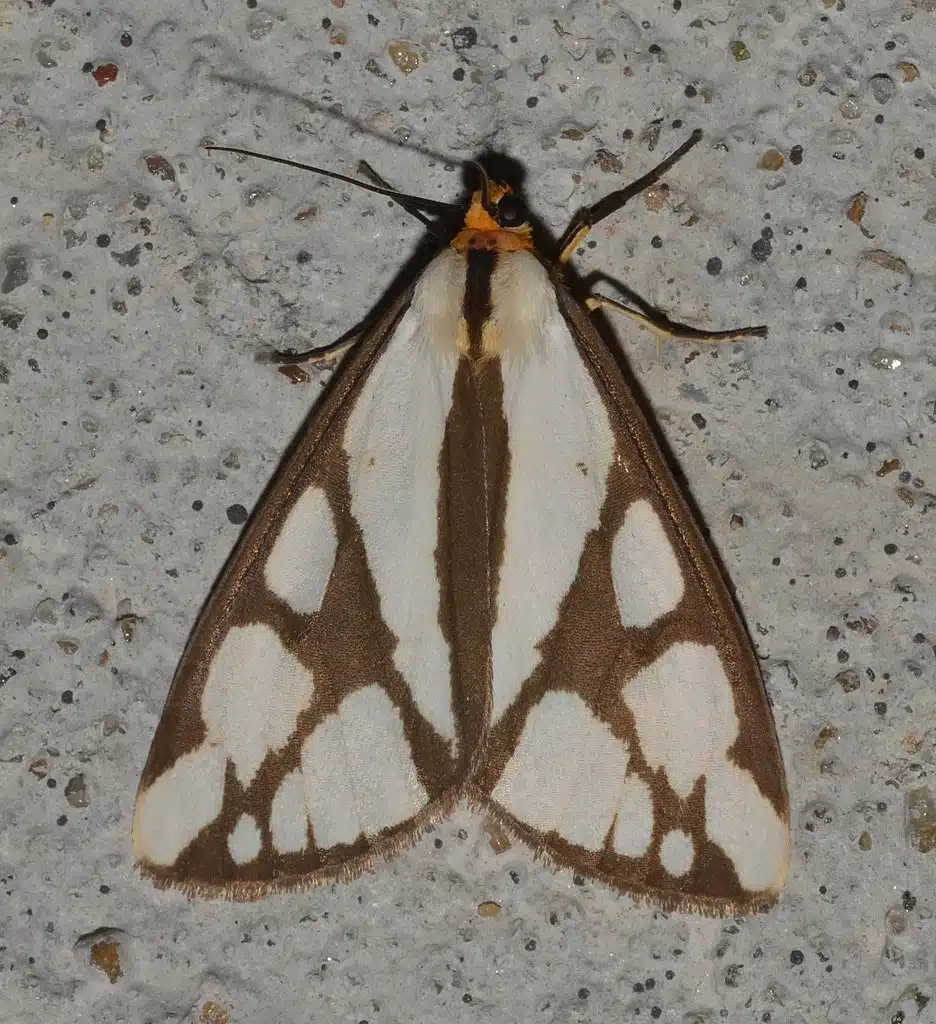
Native to North America, this species (Haploa reverse) has a white, black, and brown color.
Its wings have a base white color. The nuance is pure white which contrasts the black and brown marks across the wings.
Native to states such as Oklahoma, the species grows to a maximum wingspan of 33mm.
These moths are a common sight in orchards, parks, gardens, and on farms where they like to eat fruit-bearing trees.
Orchard apples or small apple trees are among their favorite host trees. They lay eggs on these trees and the larvae of the species feds on the leaves of the apple tree.
Preventive measures include covering the trees in a fine mesh just before these moths are in season.
Since they tend to appear in June, many cover their apple trees at the end of May.
Only one late generation of Reversed Haploas is seen every season.
35. White Underwing
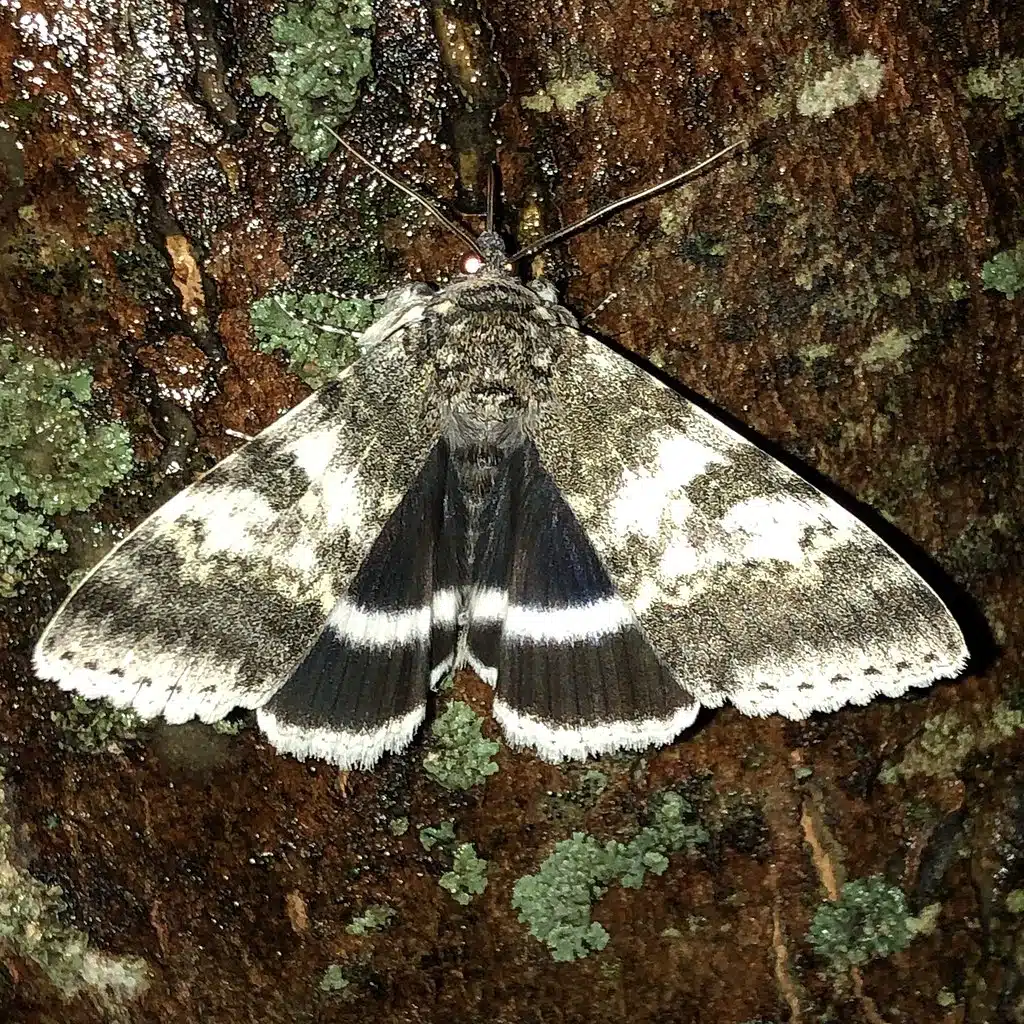
White Underwing moths (Catocala relicta) are native to Eastern and Western parts of North America including those in Canada.
The species is known to have different patterns on the forewings compared to those on the hindwings.
White Underwings are dominated by black and white colors but the patterns of the wings are highly different.
The forewings have a base white color with multiple black spots which may have double white and black borders.
The hindwings of the White Underwing are unique in North America. They are mostly black with white diagonal bands.
The body of this moth is also black with white bands similar to those on the hindwings.
Like other native species, these moths are also interested in laying eggs on trees.
Hardwood trees at high altitudes are among the preferred host trees. Poplars and various species of aspen are among the trees most affected by White Underwings.
36. American Ermine Moth
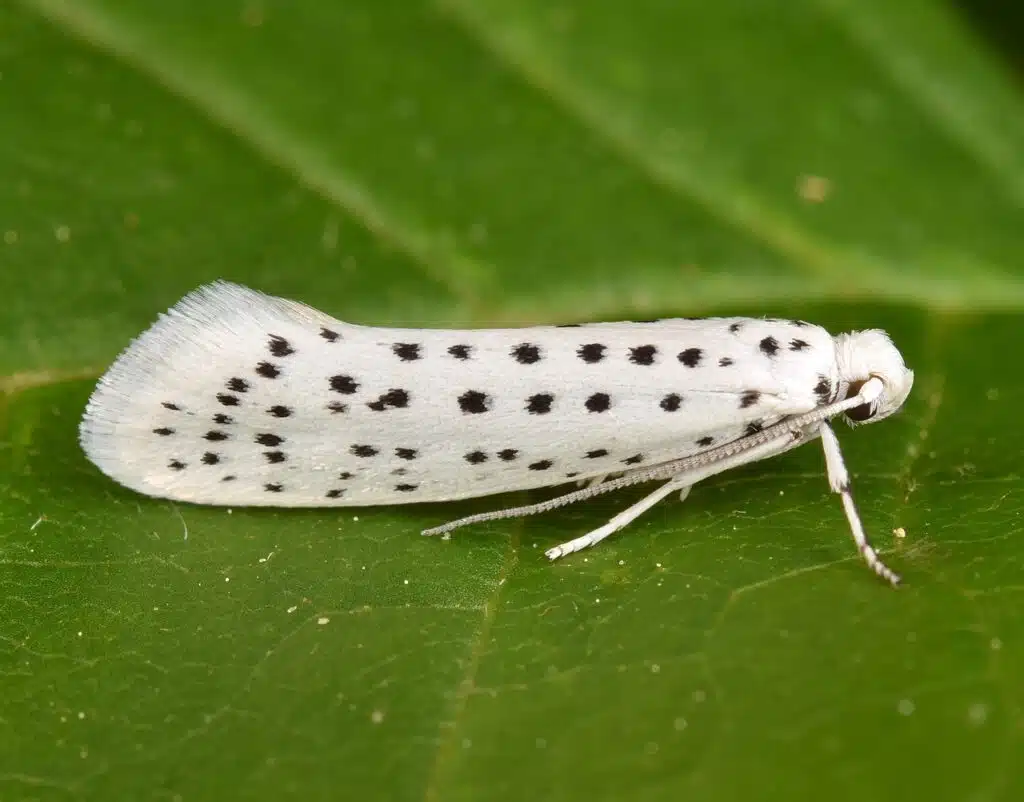
The white and black American Ermine moth (Yponomeuta multipunctella) is a common species in the US and Canada.
This moth has a white base color. Pure white characterizes its wings, head, antennae, and legs.
Tiny black spots are further distinguishable on its wings. Multiple small white dots are seen across the wings of the species.
White base coloring with black dots is further seen on its head.
This moth species is a known pest in gardens. You might see it in your garden where it’s probably laying eggs on a few species of strawberries.
Alternatively, it can also use viburnum flowering plants as hosts.
37. Filigreed Moth
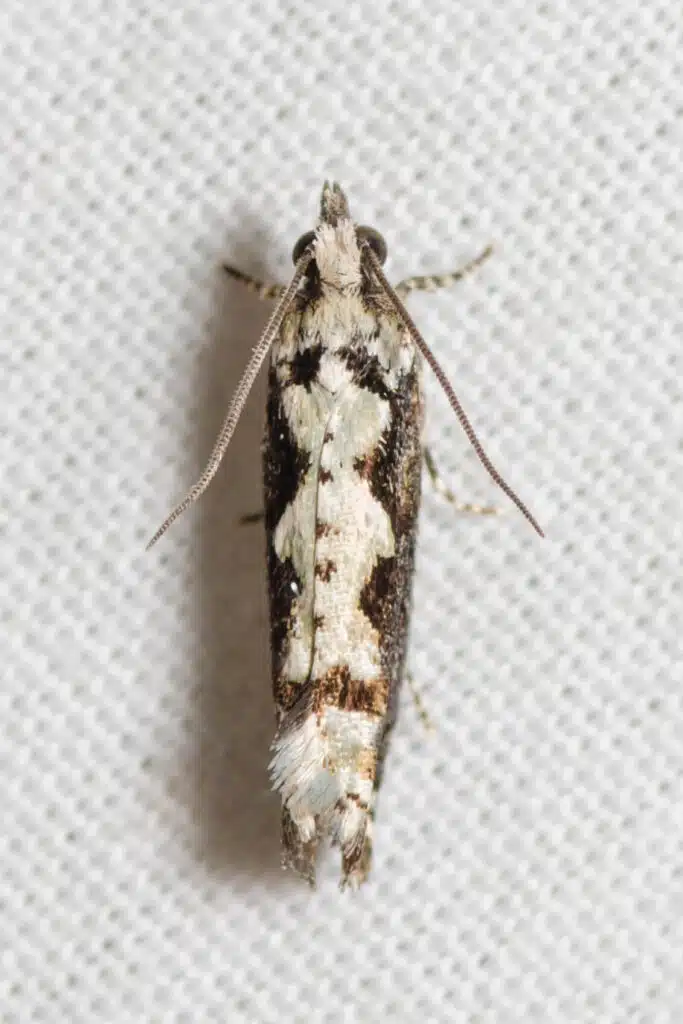
The Filigree moth (Chimoptesis pennsylvaniana) has a widespread presence in multiple US states from Ohio to Florida.
Its coloring differs from the forewings to the hindwings and it makes the species look different from other Eastern native black and white moths.
Filigree moths have black and white forewings. Black is the main color of the wings while white is seen as marks or splatter across the lower part of the forewings.
When this species has its wings closed the black and white forewings are visible.
The hindwings of the species have different coloring and no patterns making for a contrasting look. The hindwings are off-white to gray. The body of the species also has an off-white color with white bands.
While the habitat of the species is diverse, its black and white wings help it remain undetected on certain surfaces.
Predators tend to move away more when the moth sits on tree bark, sandy soil, or bare ground due to the coloring of its wings. It’s only when flying that its hindwings are visible further.
Further Reading: